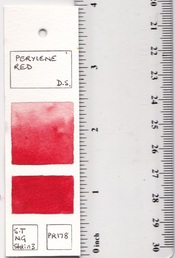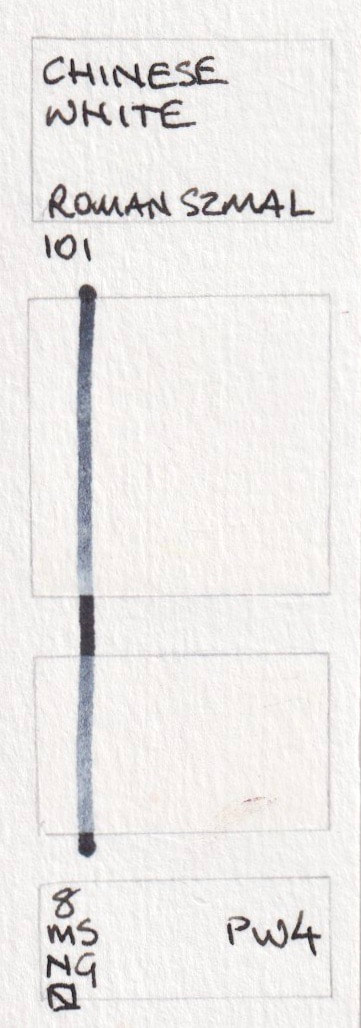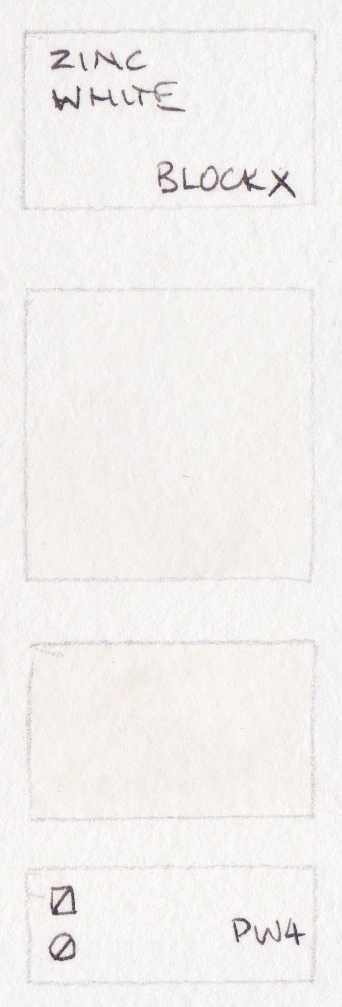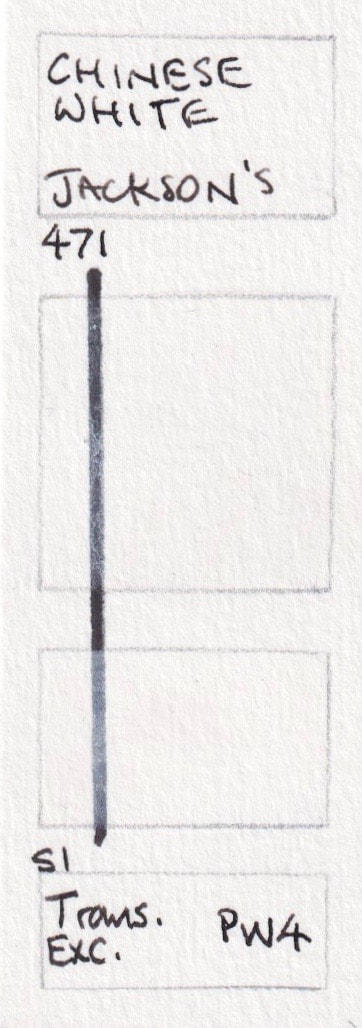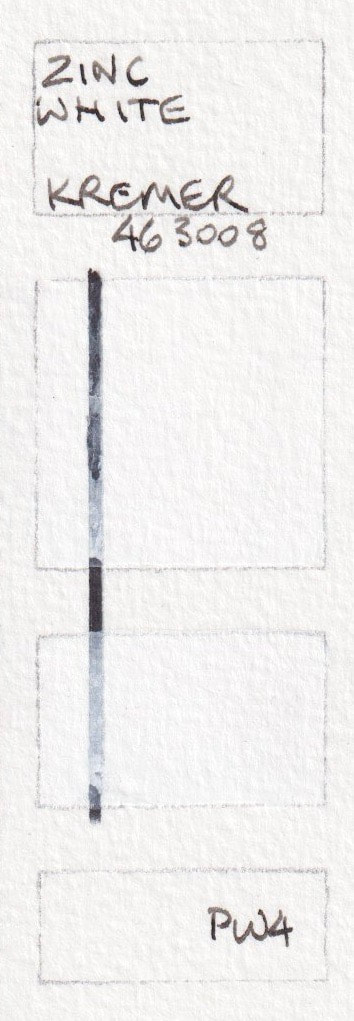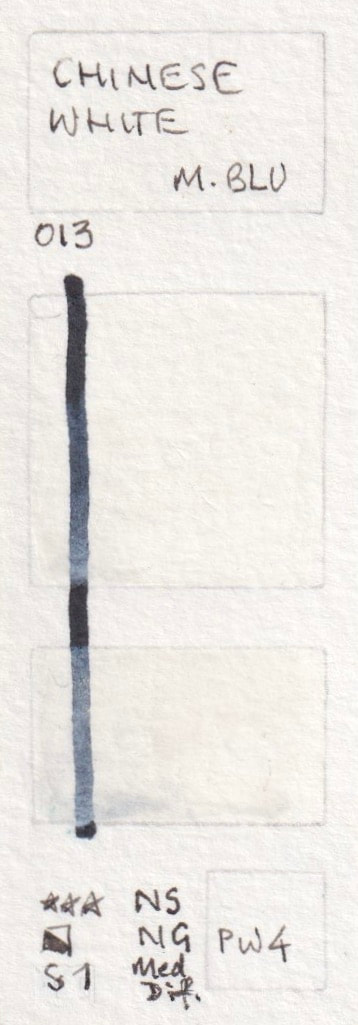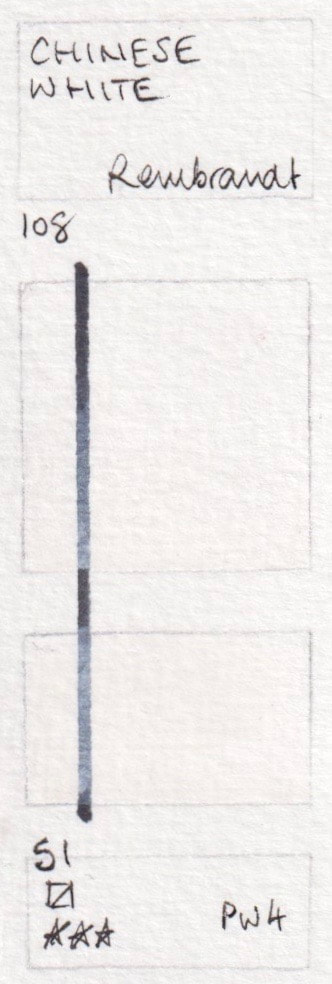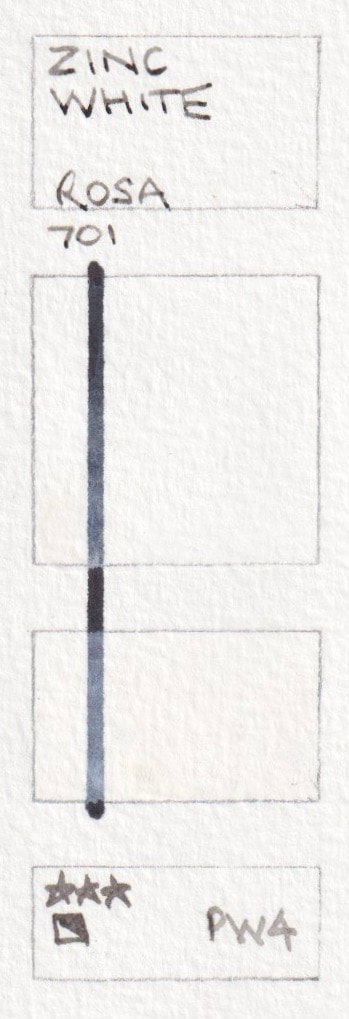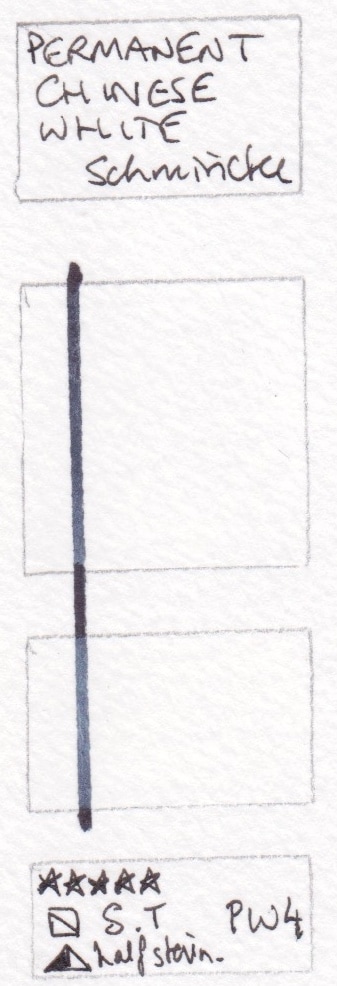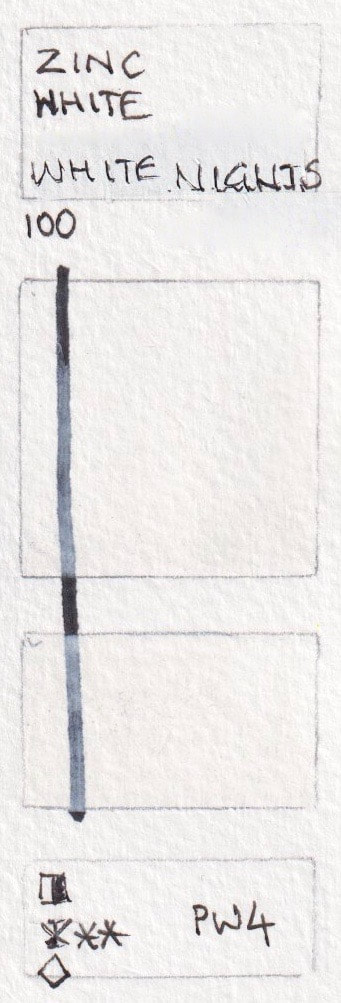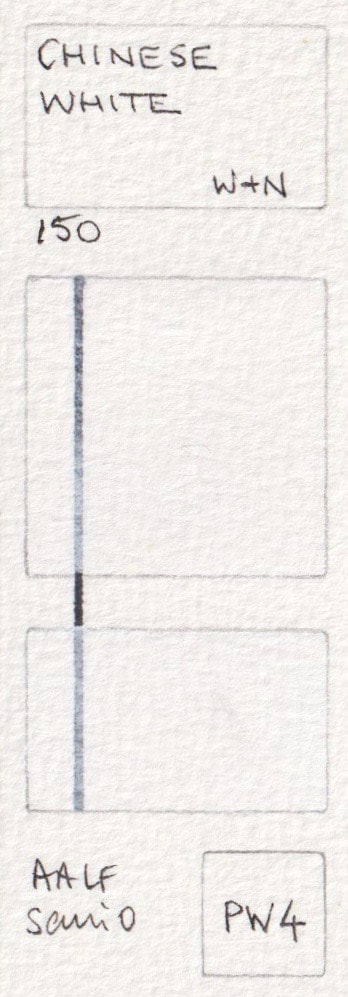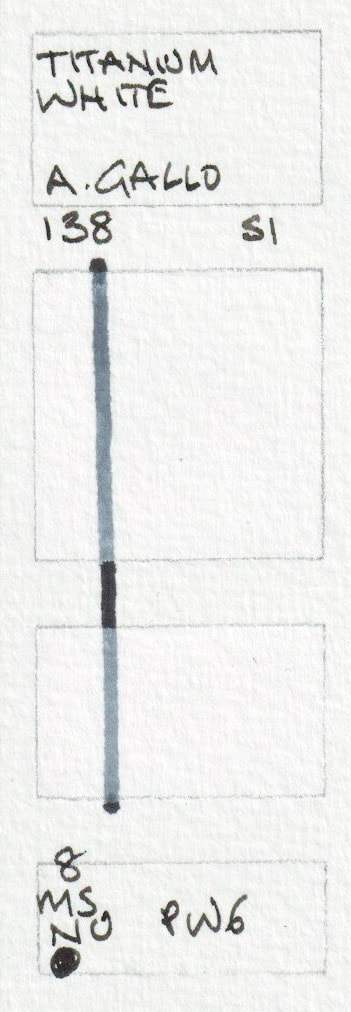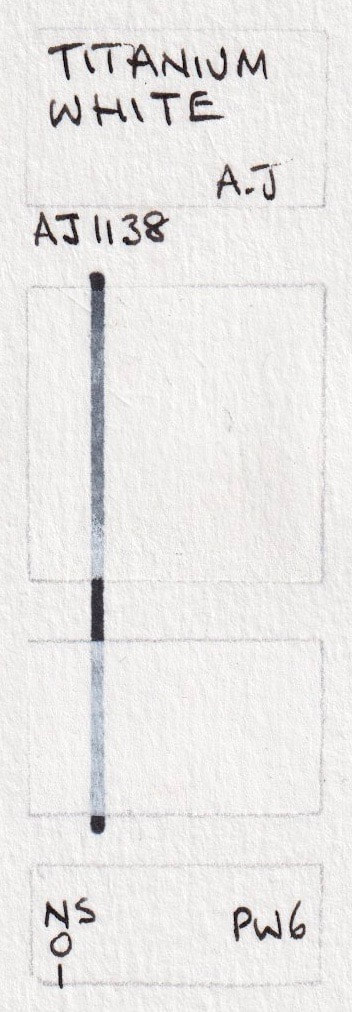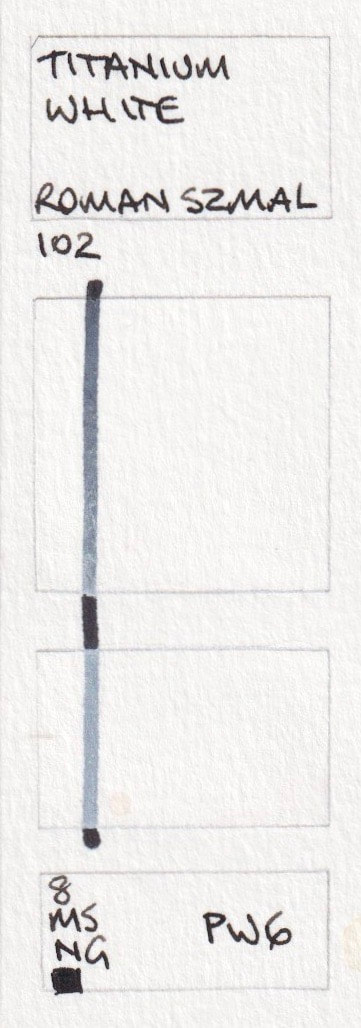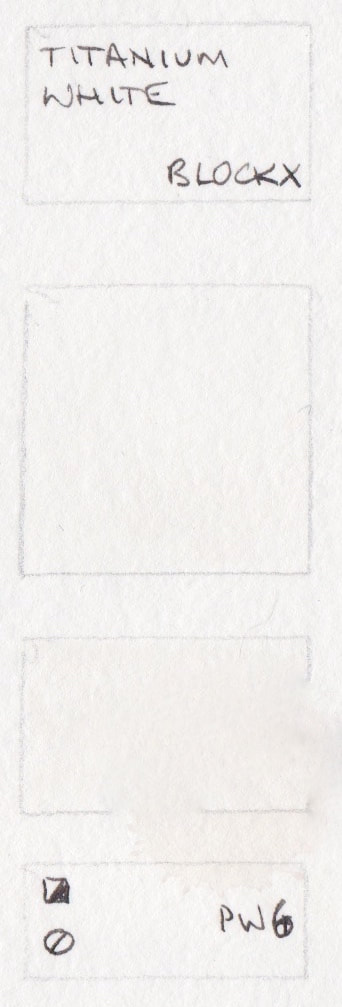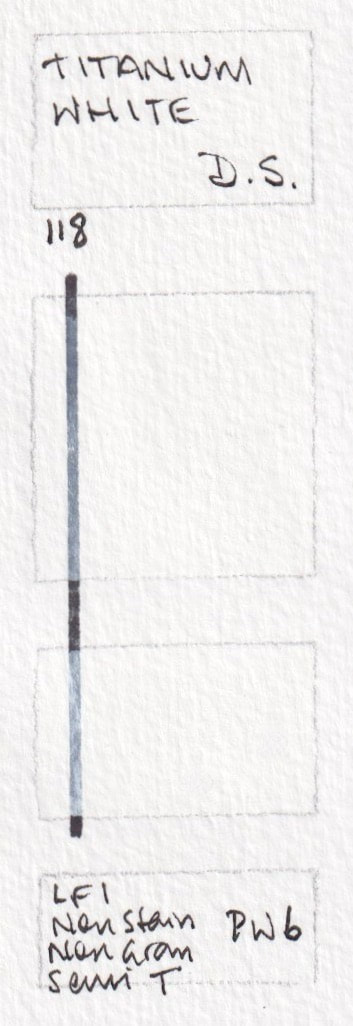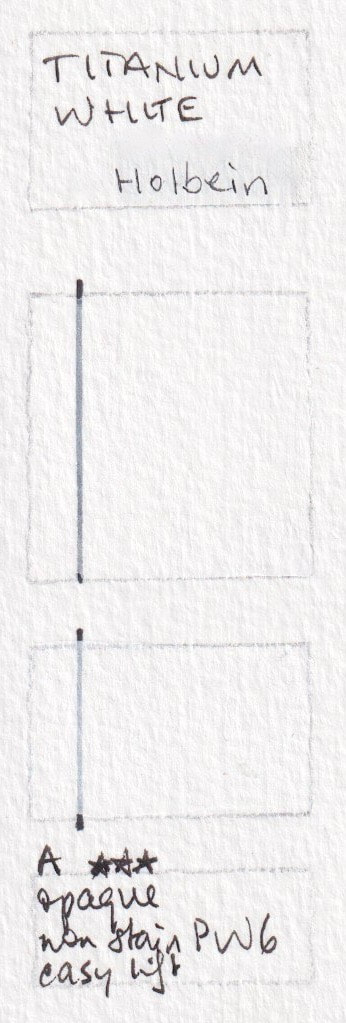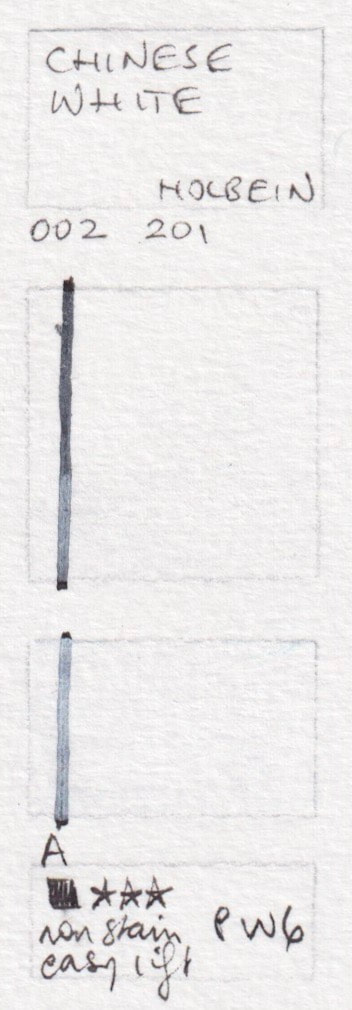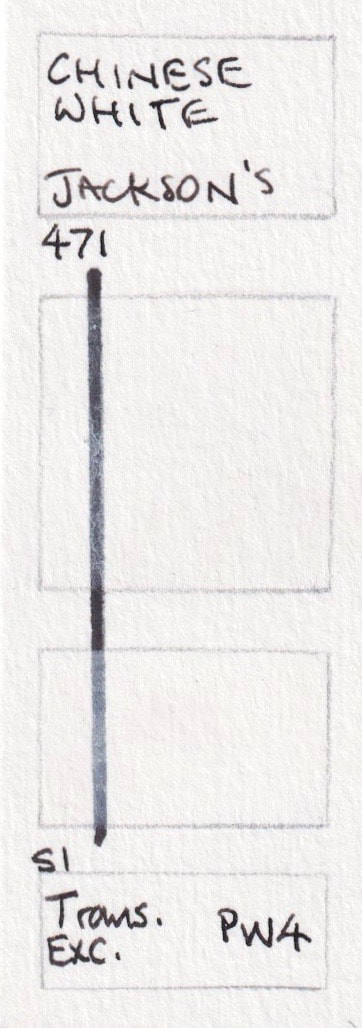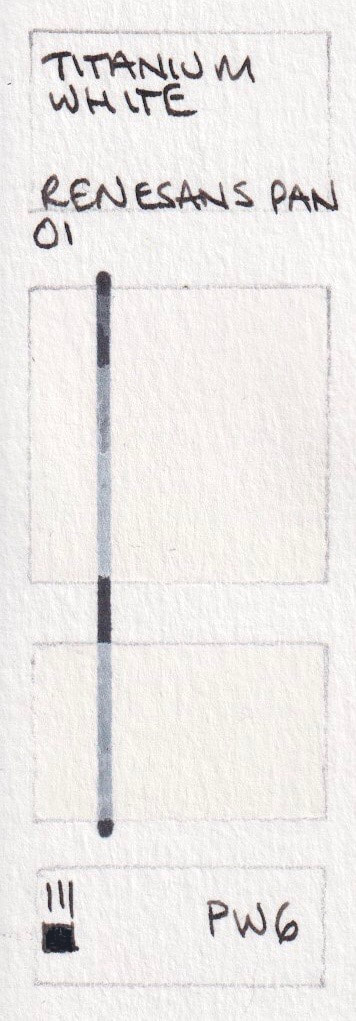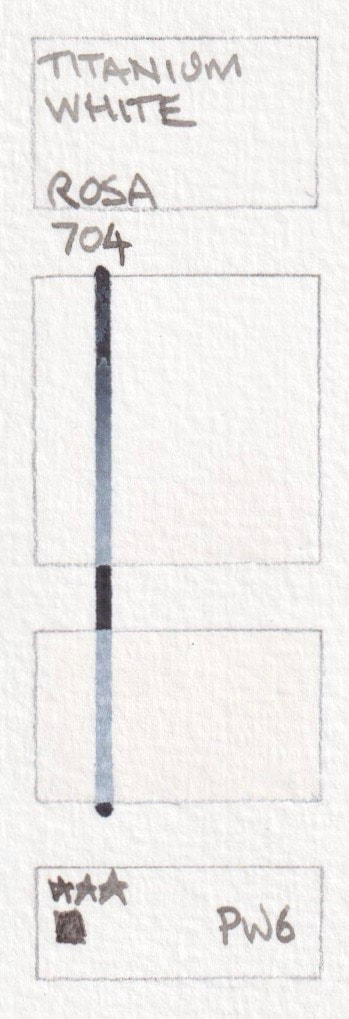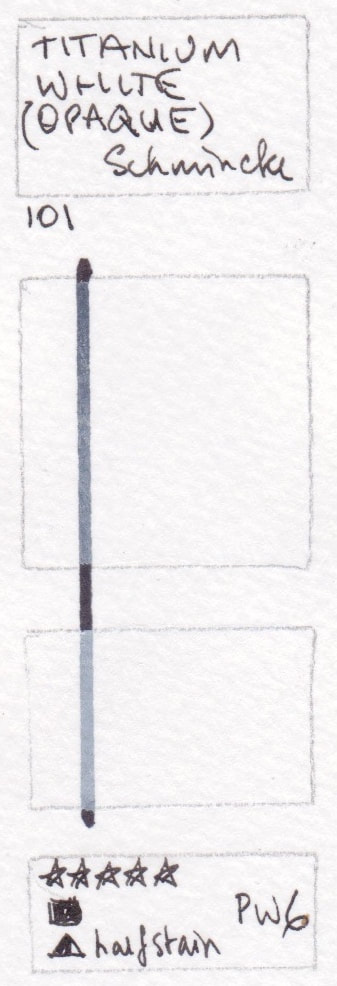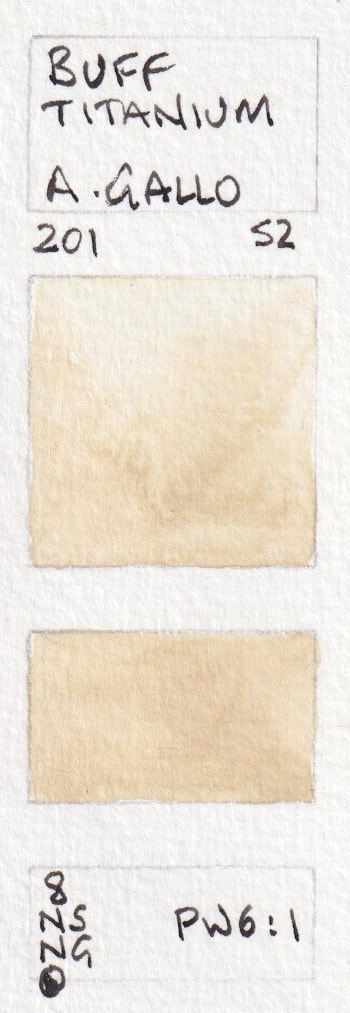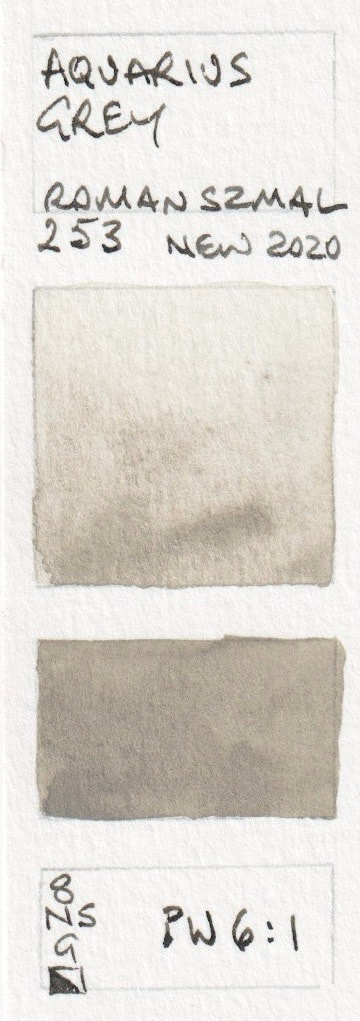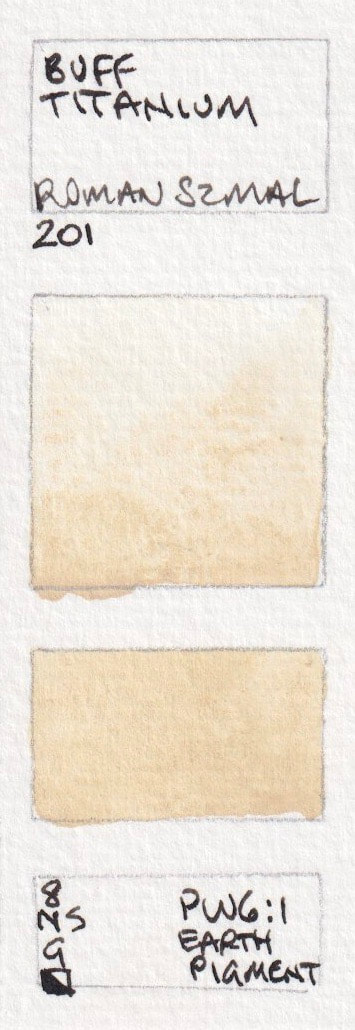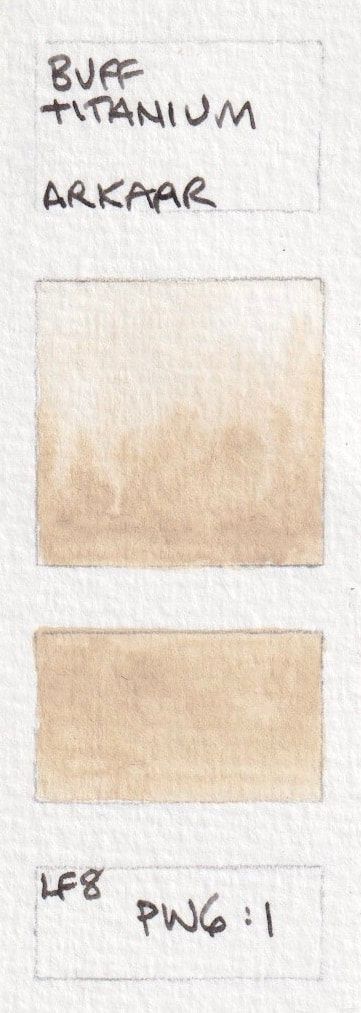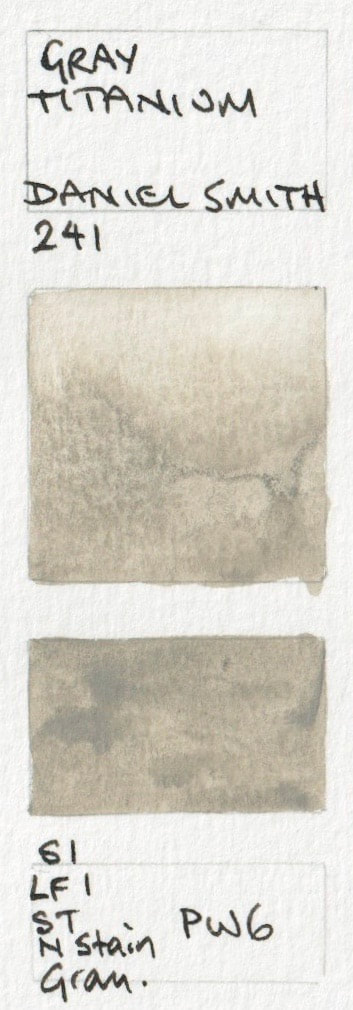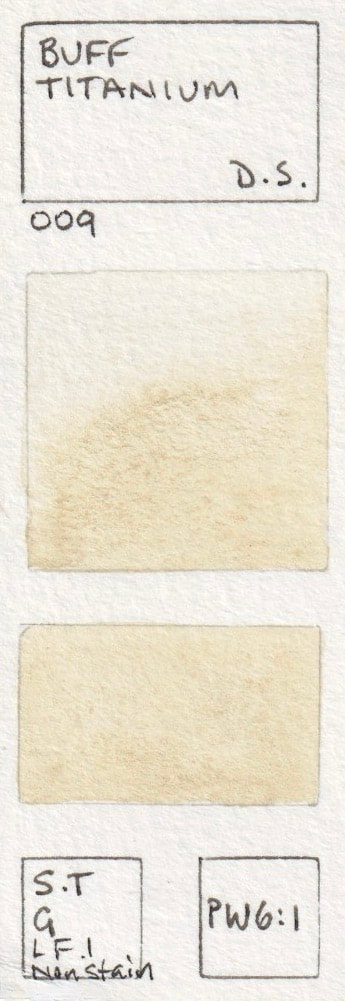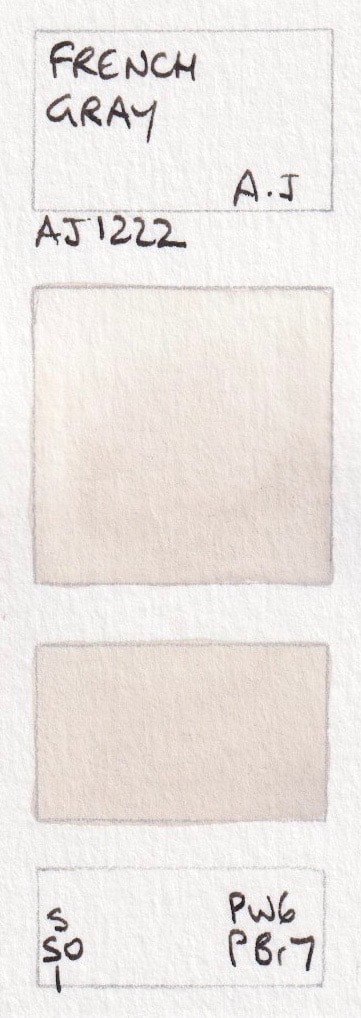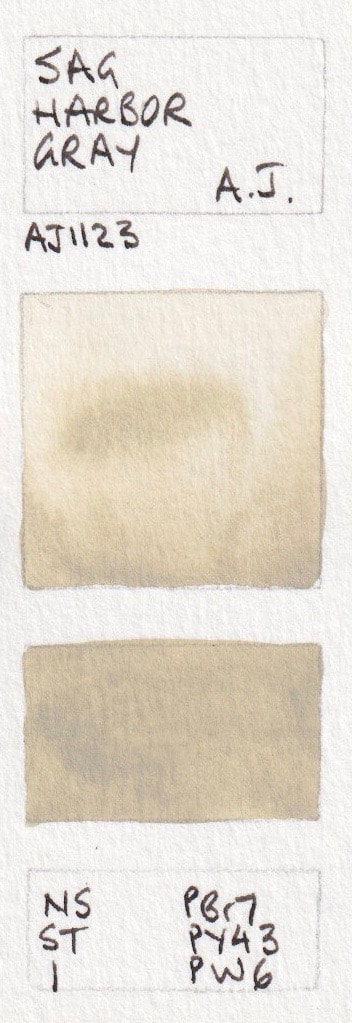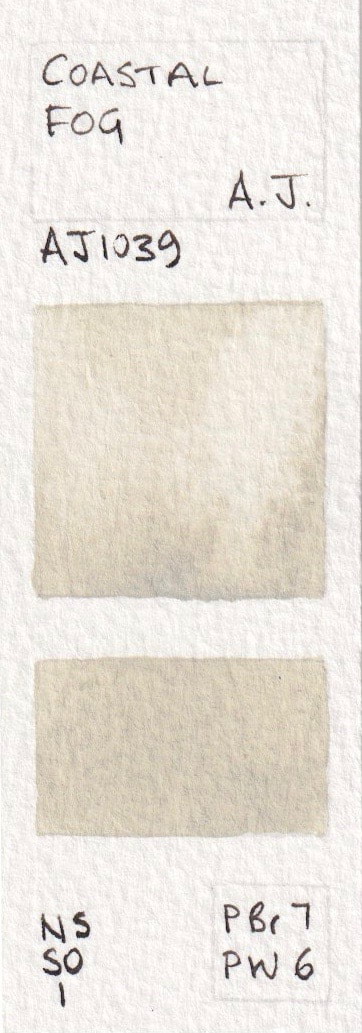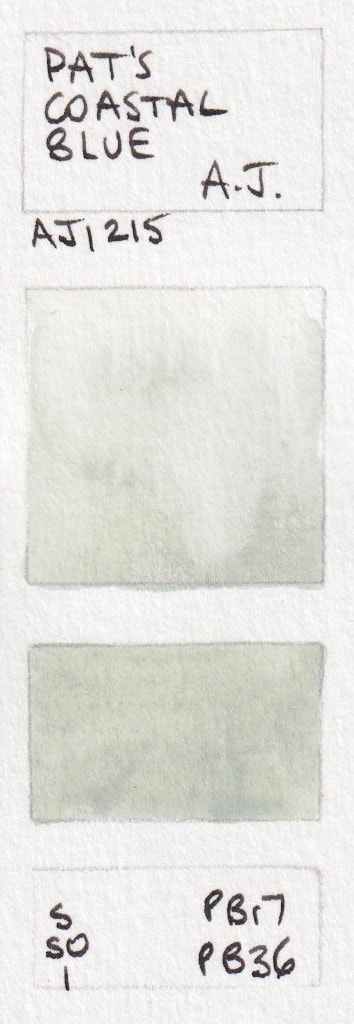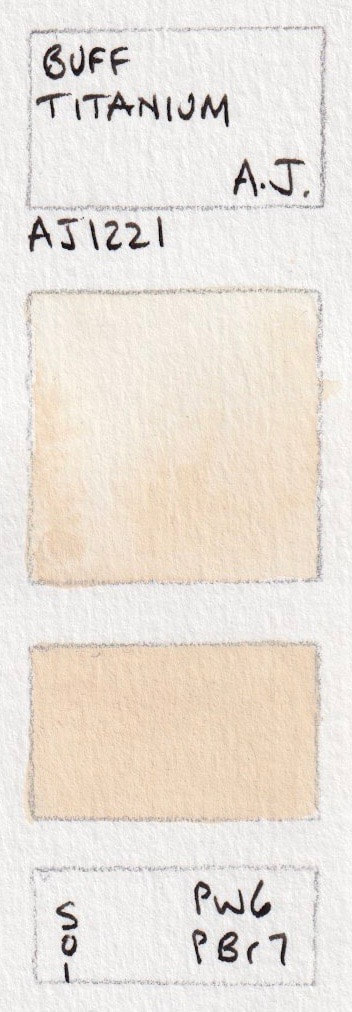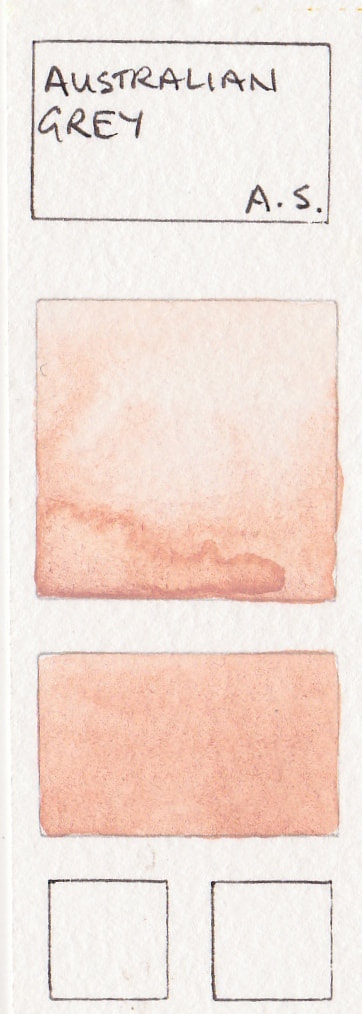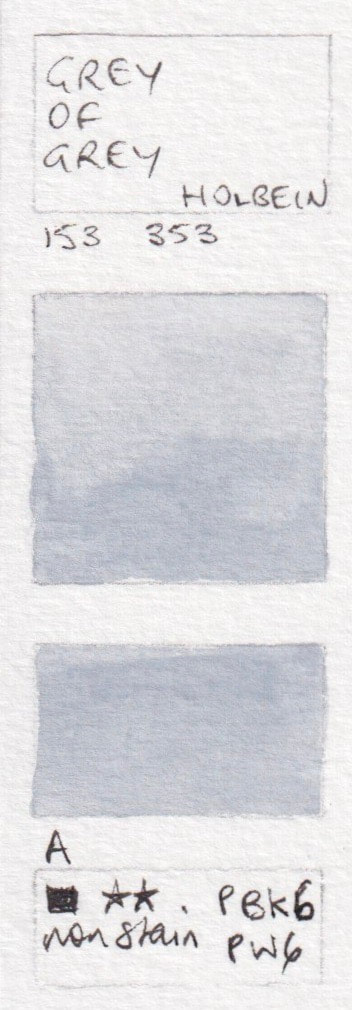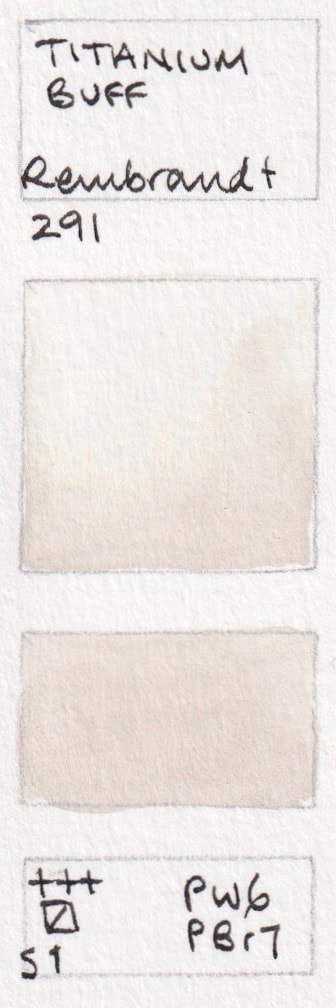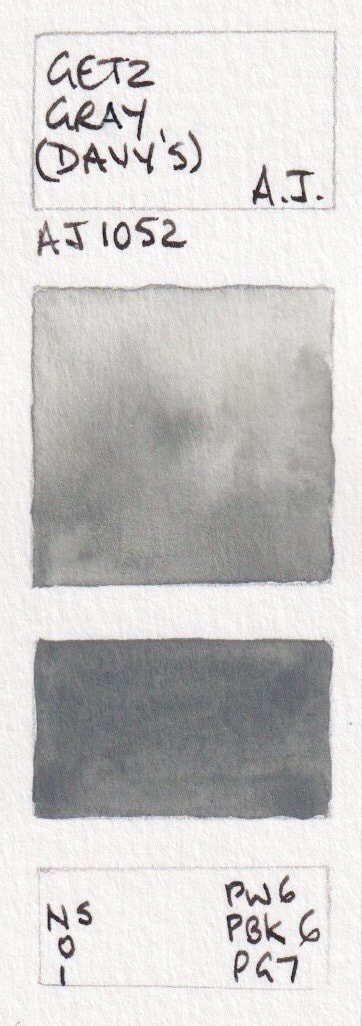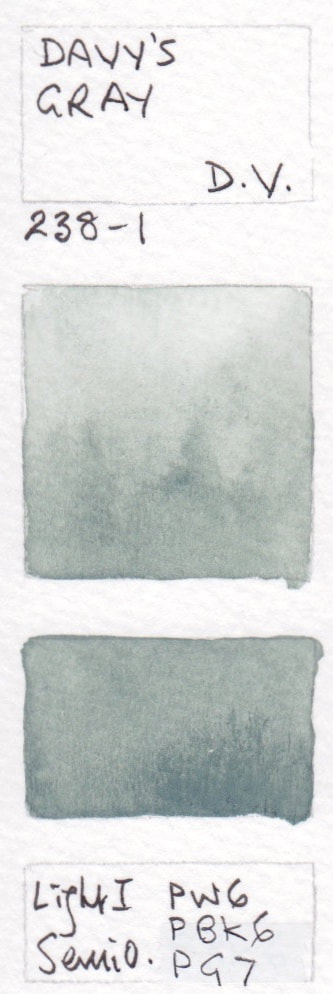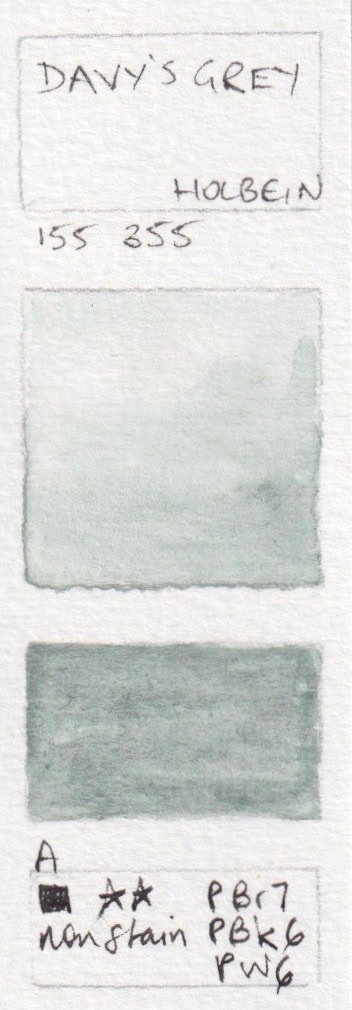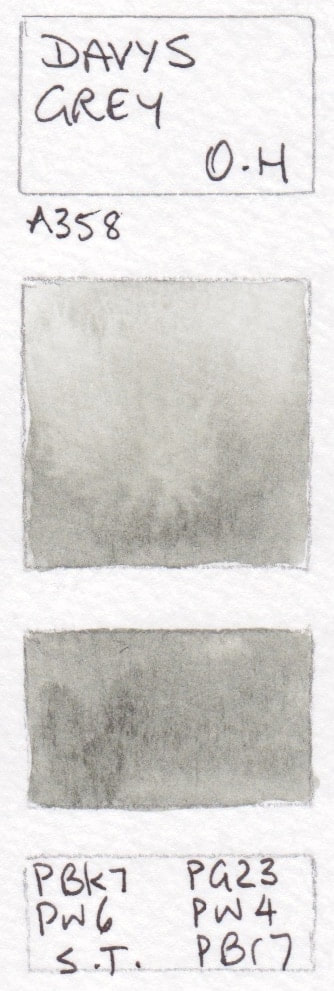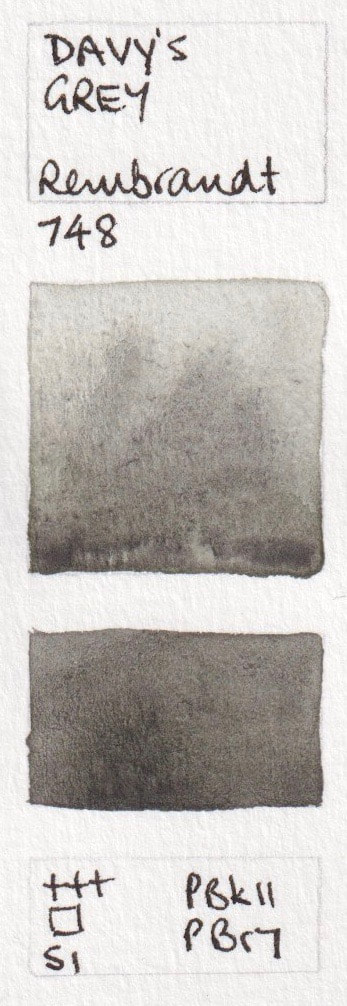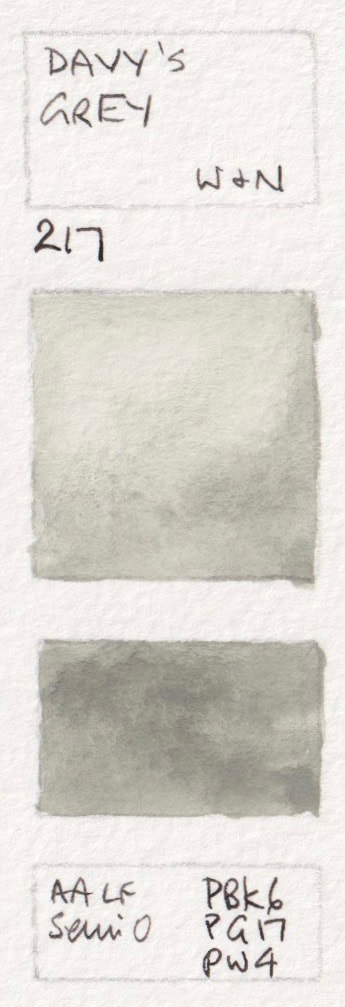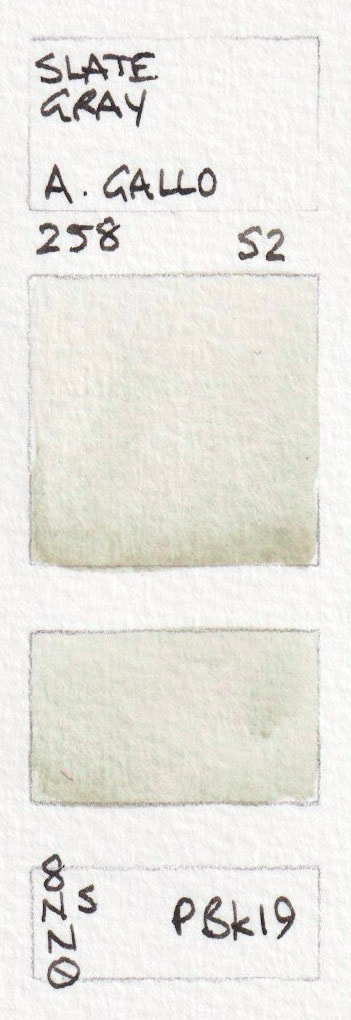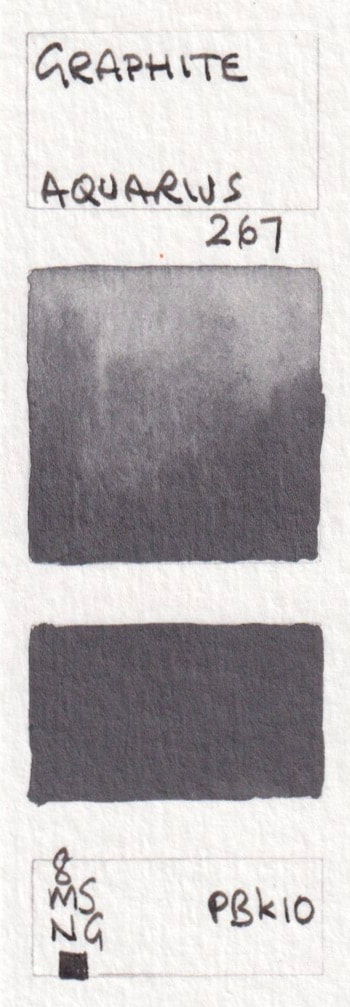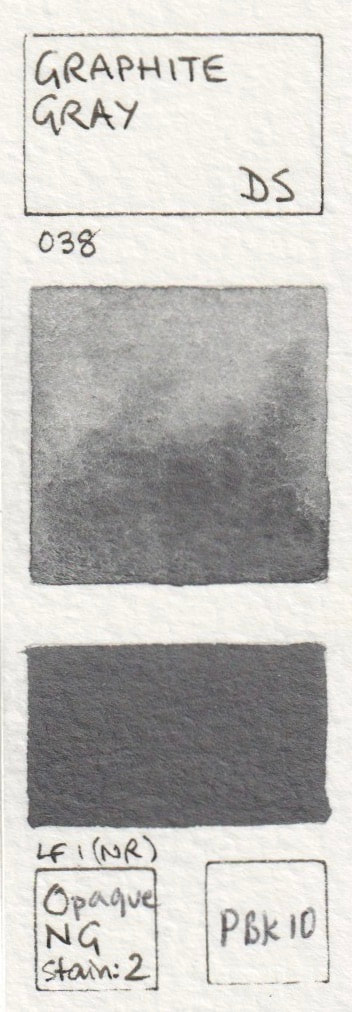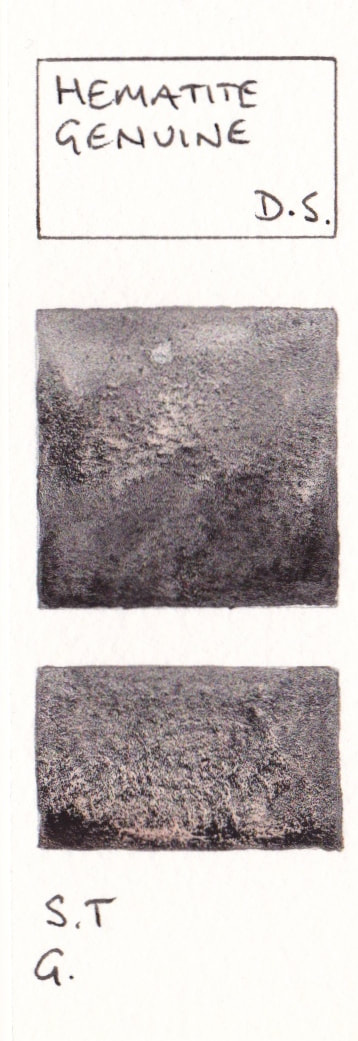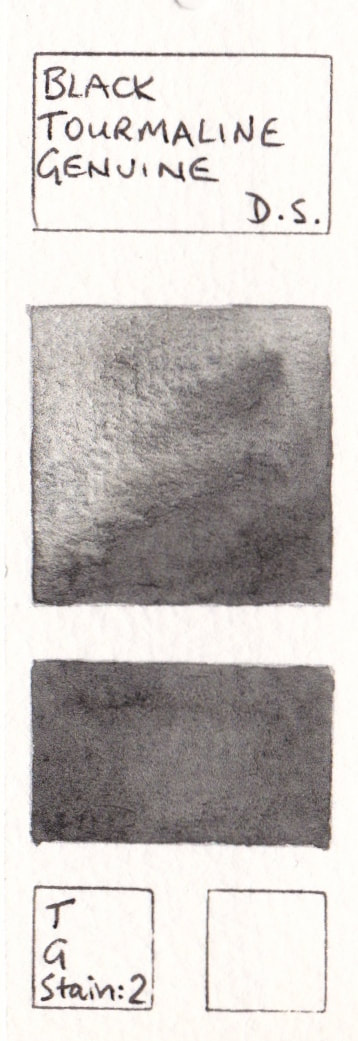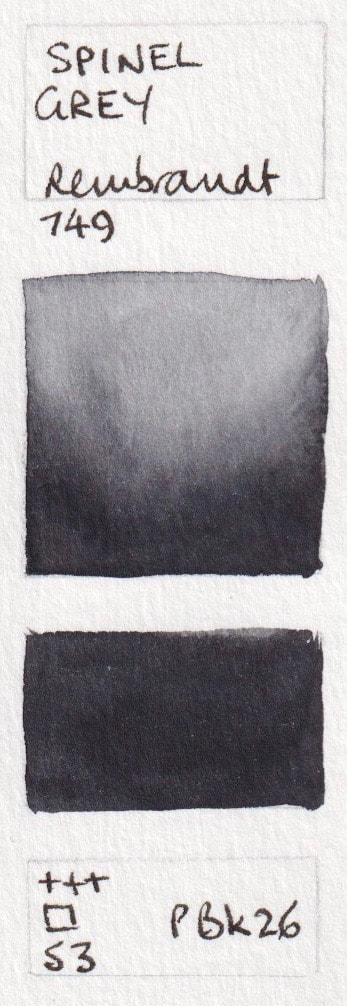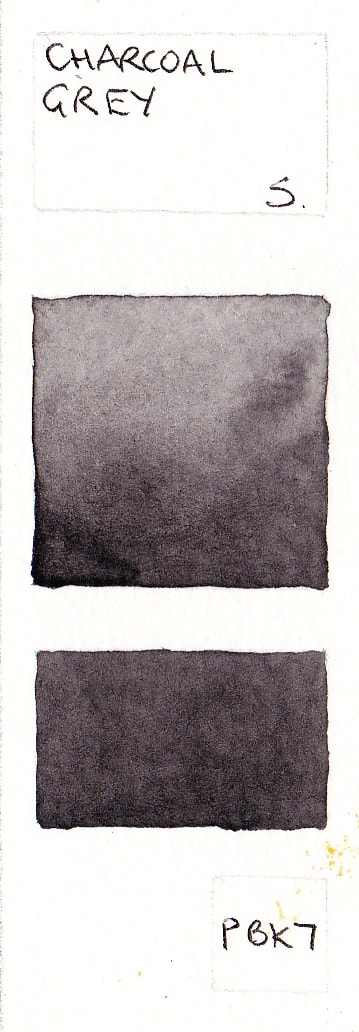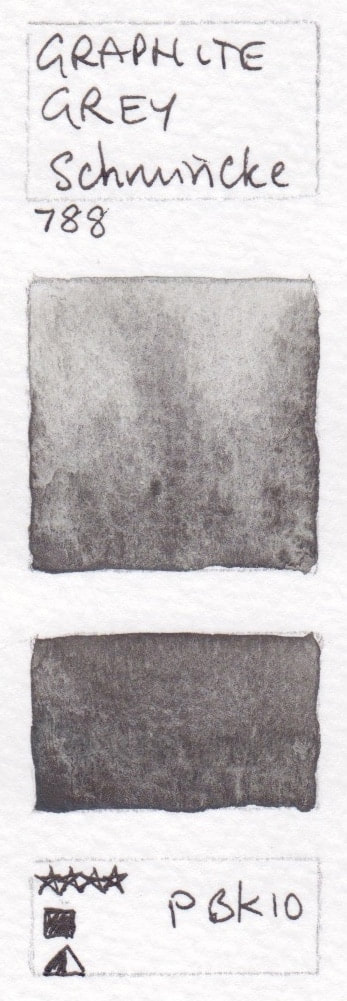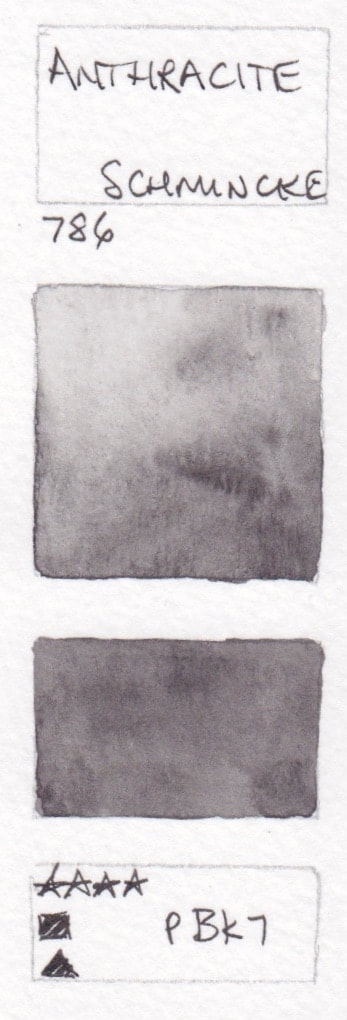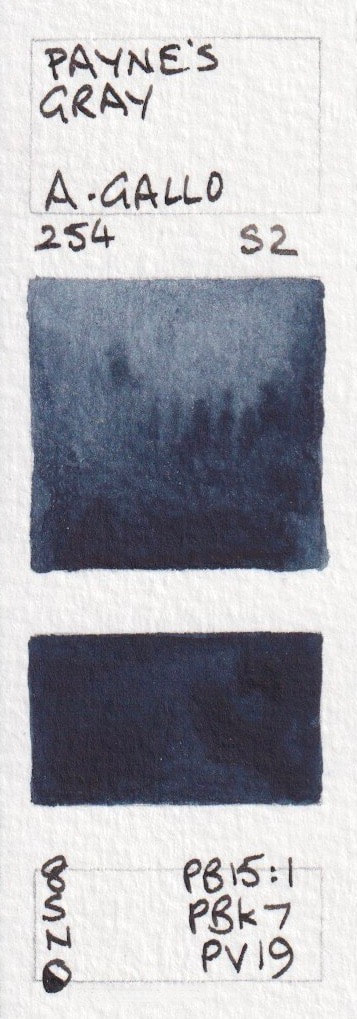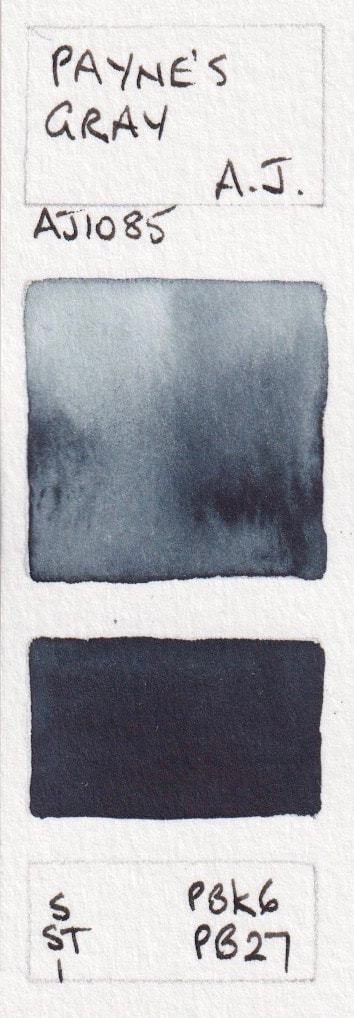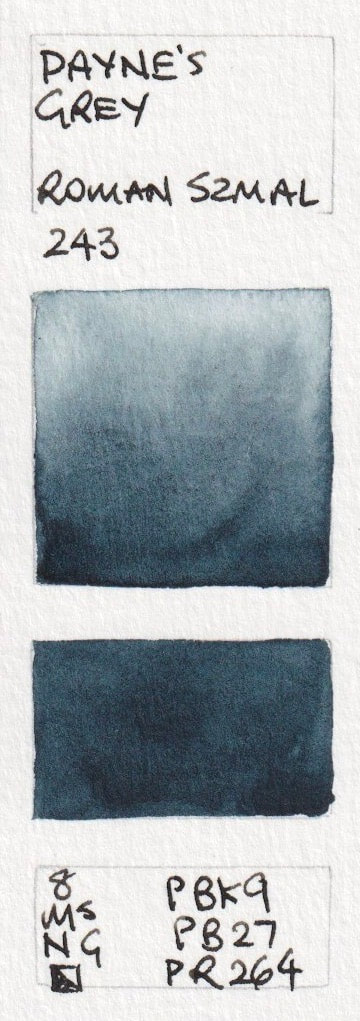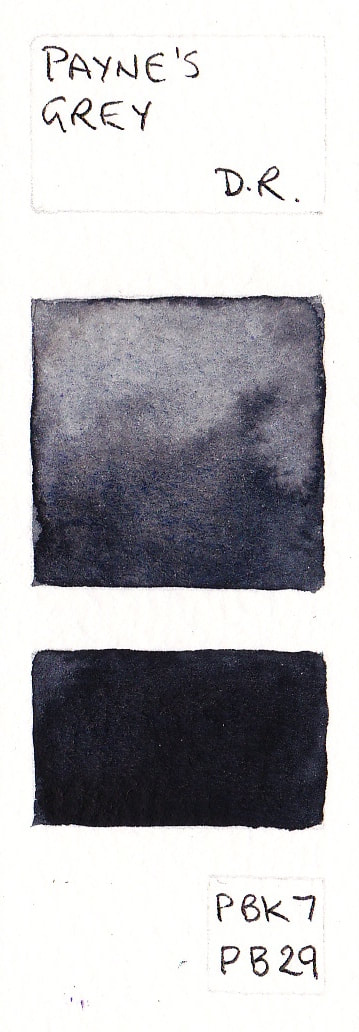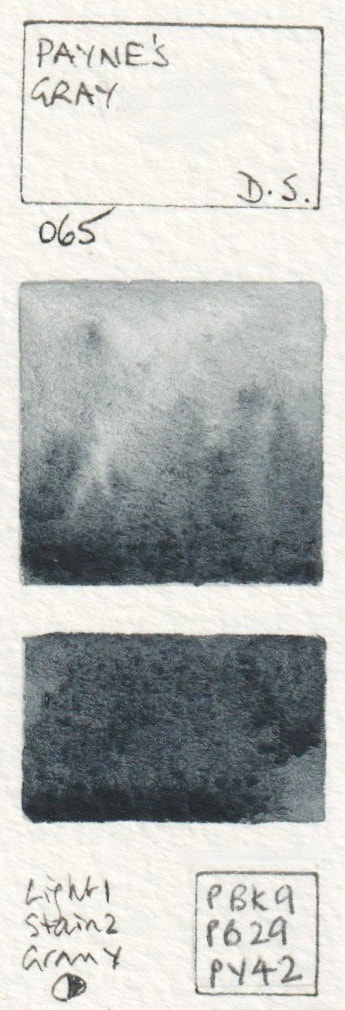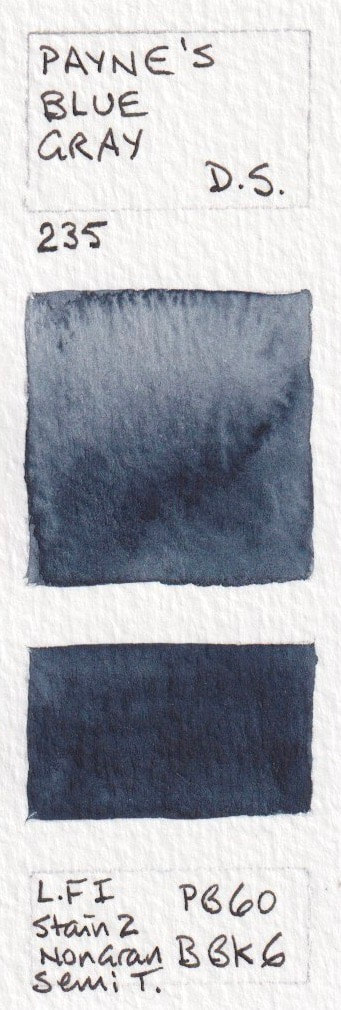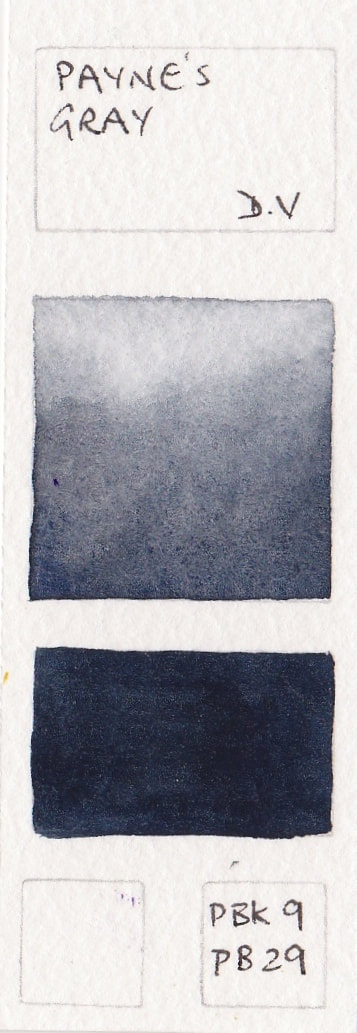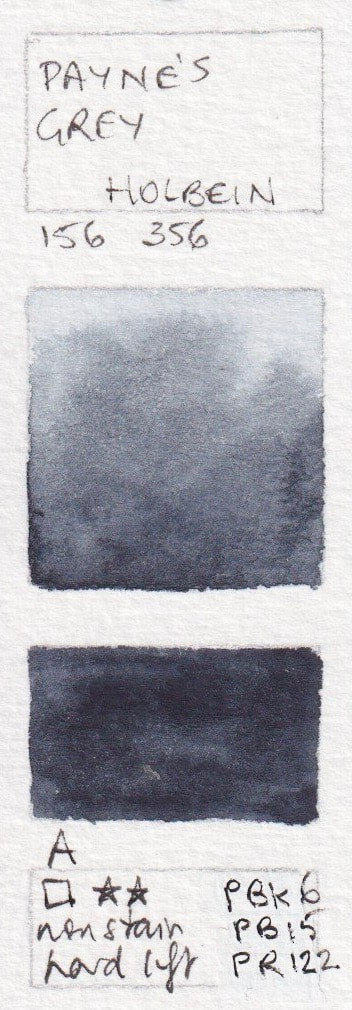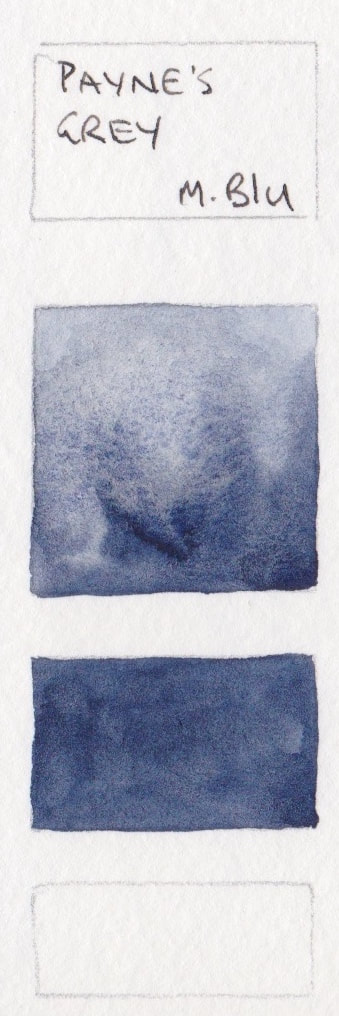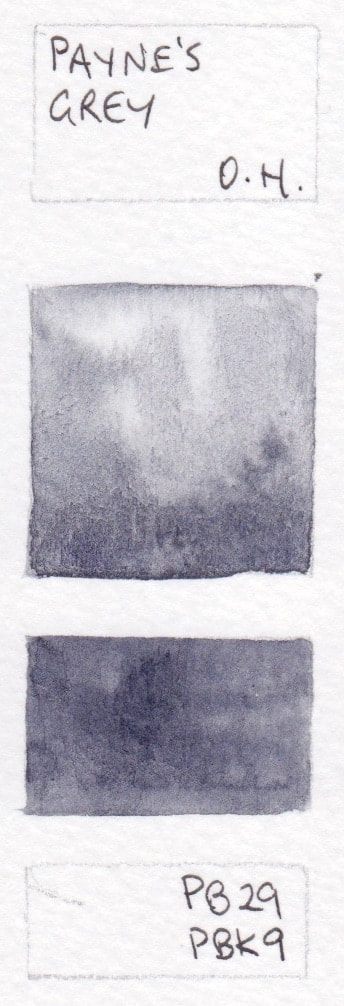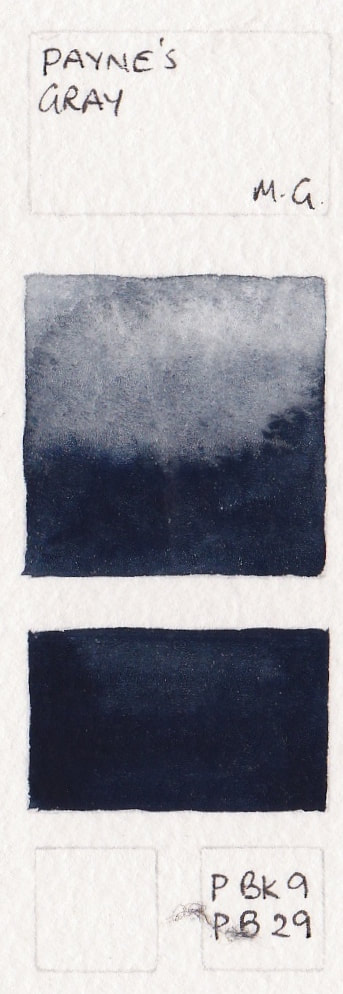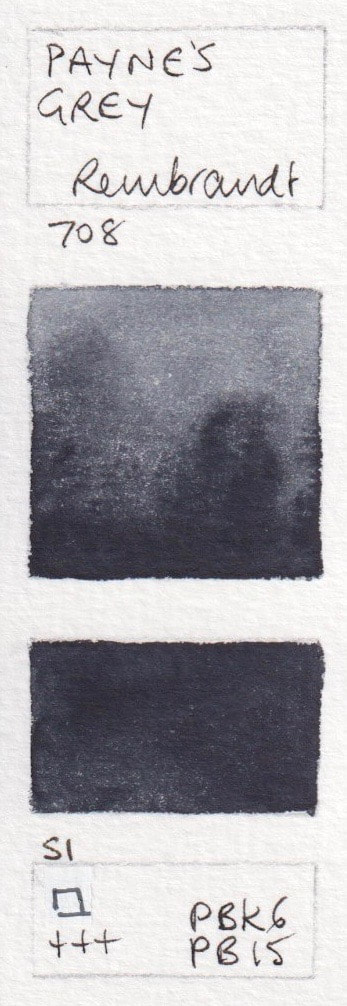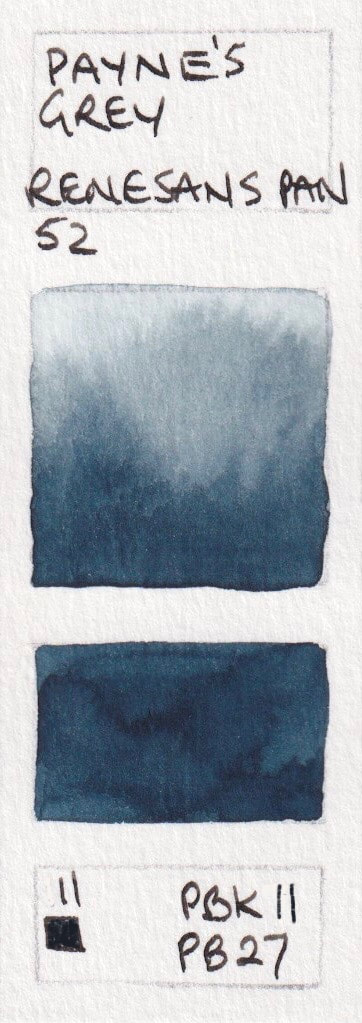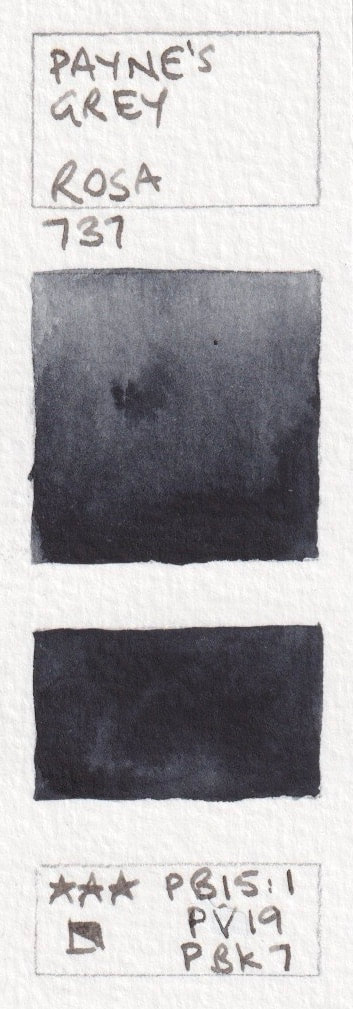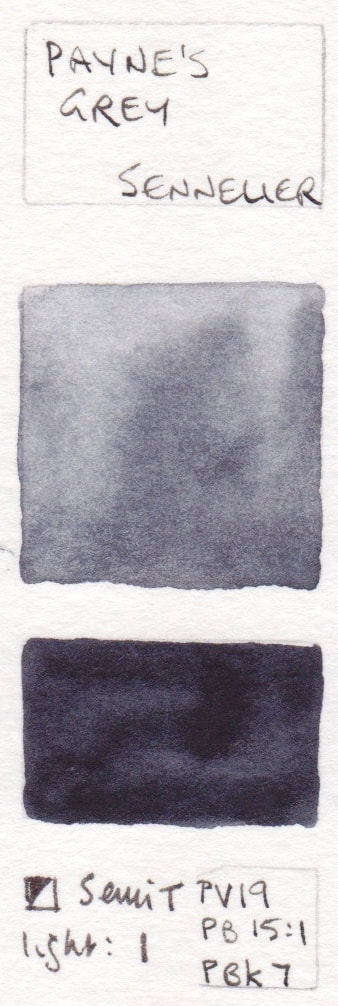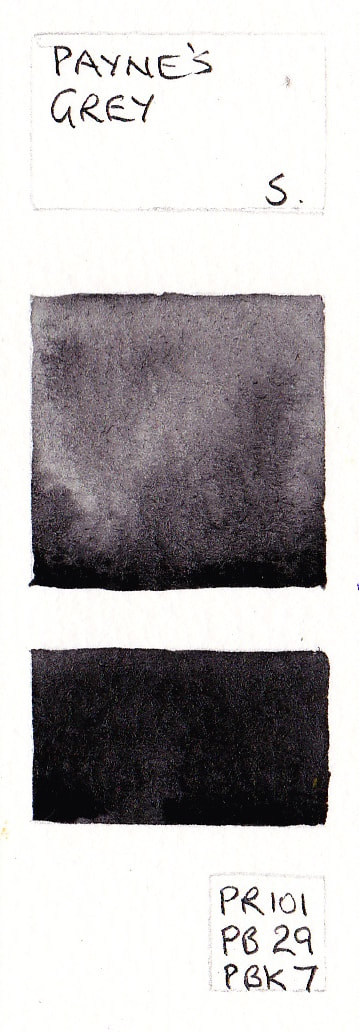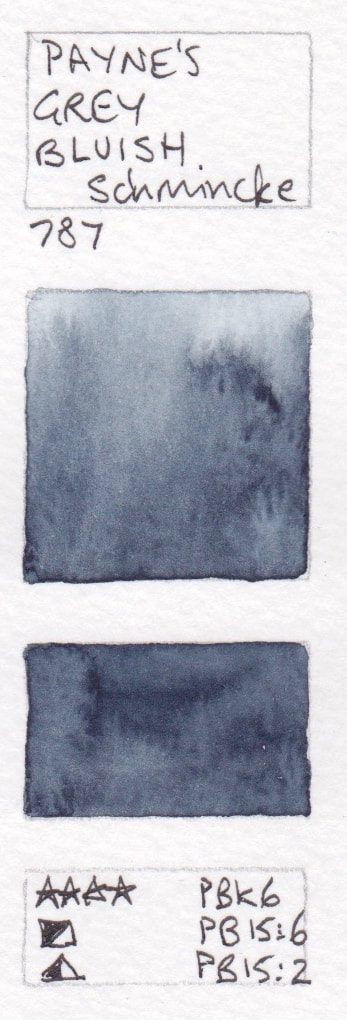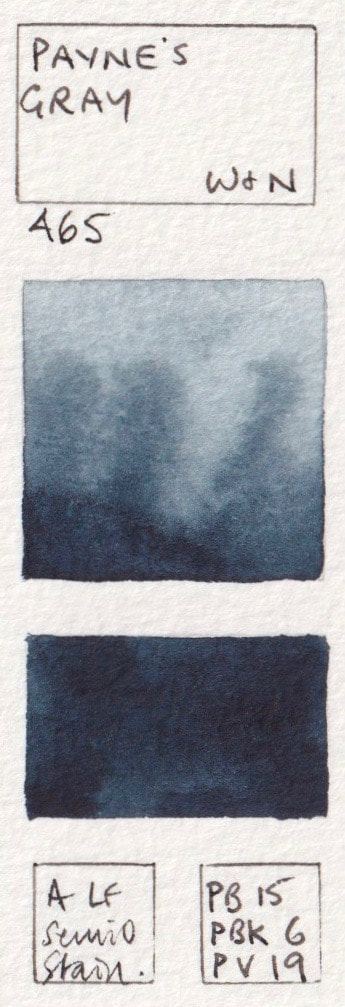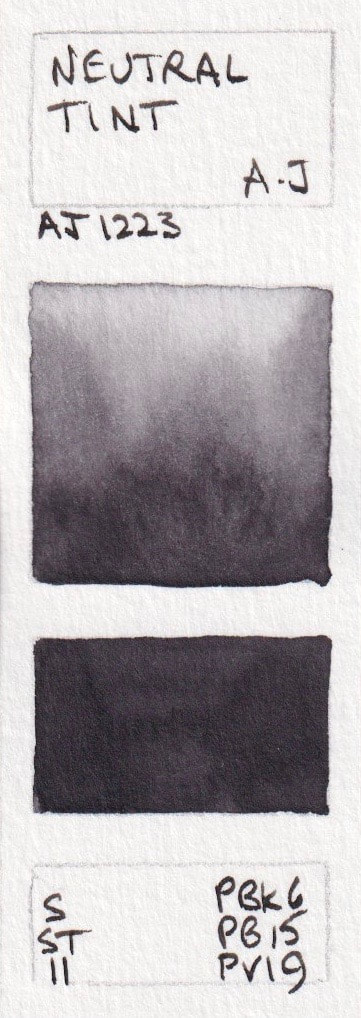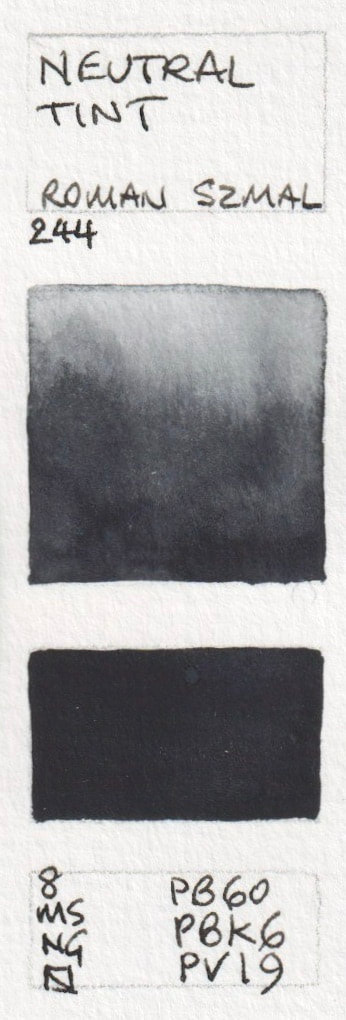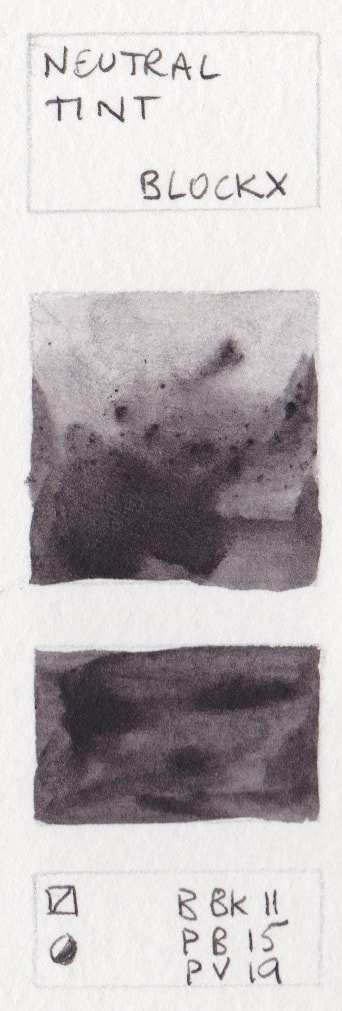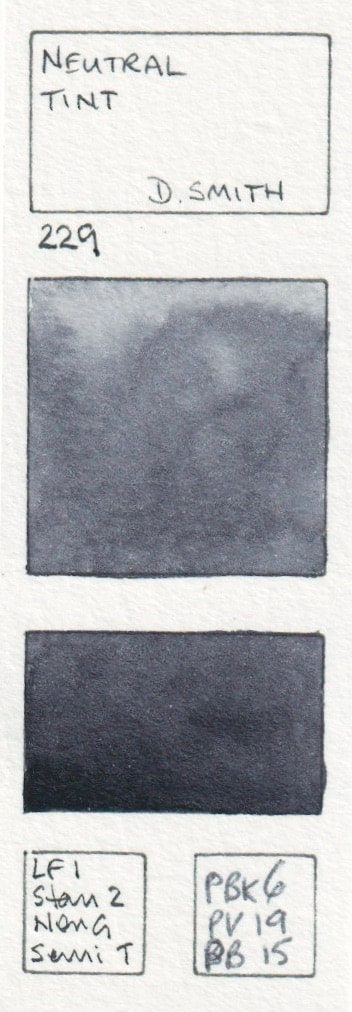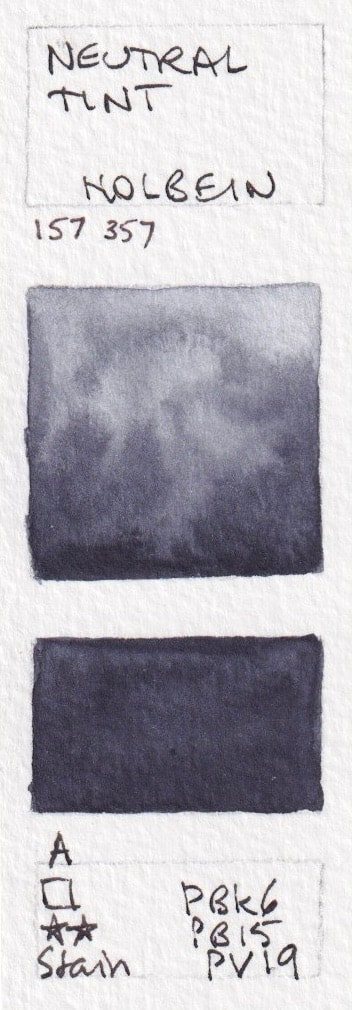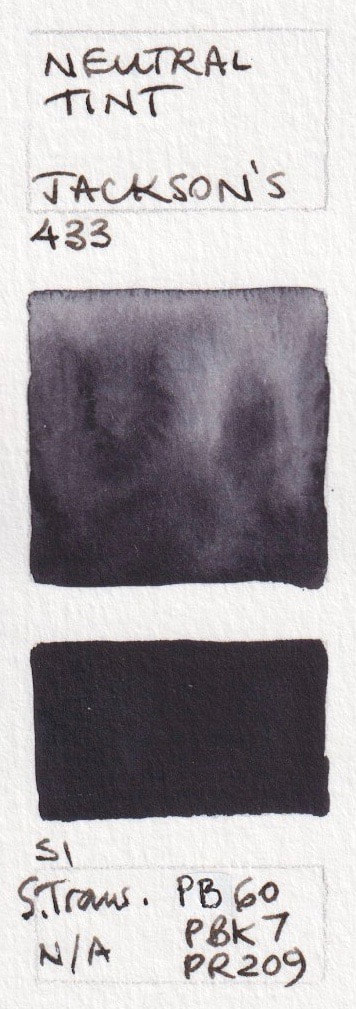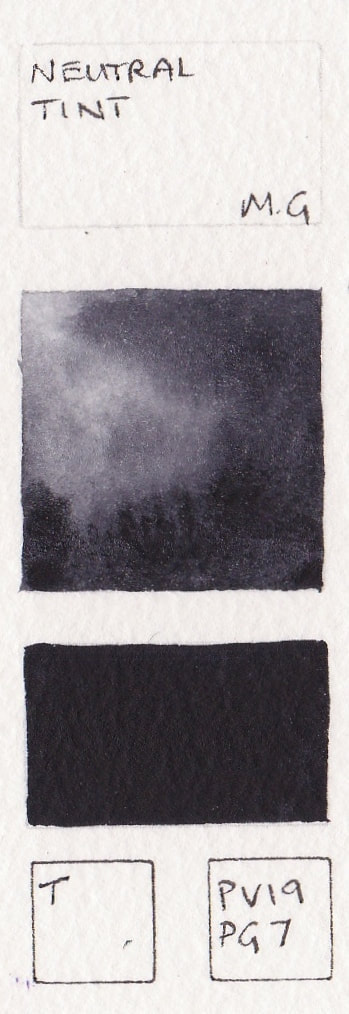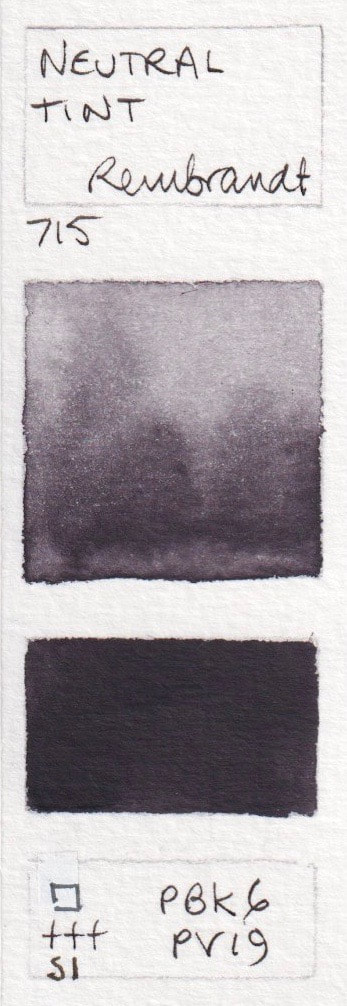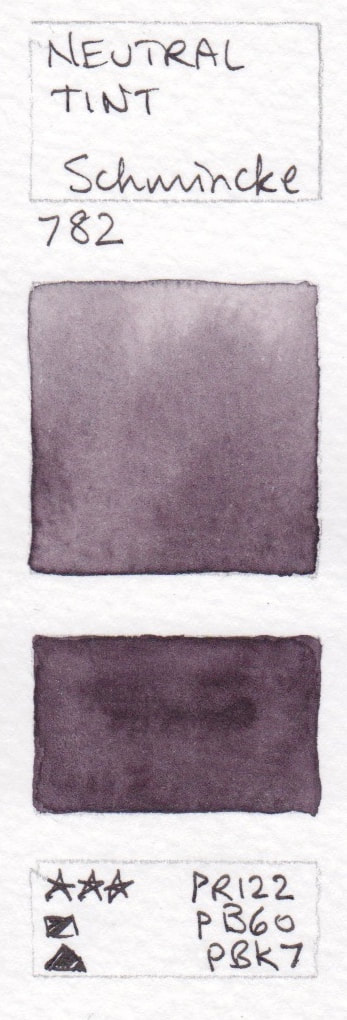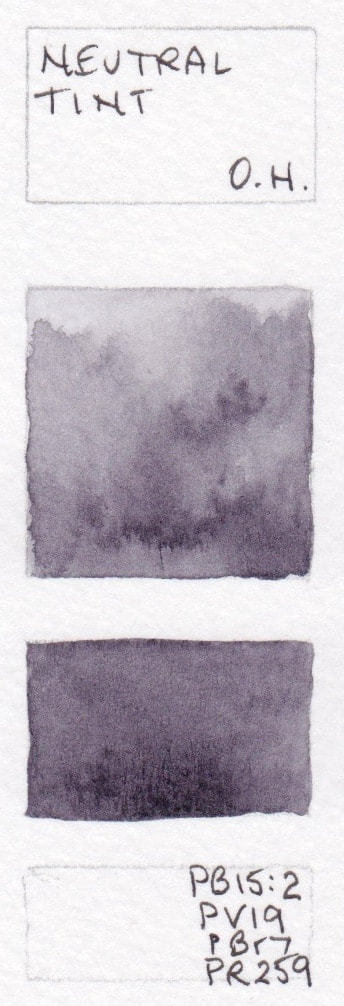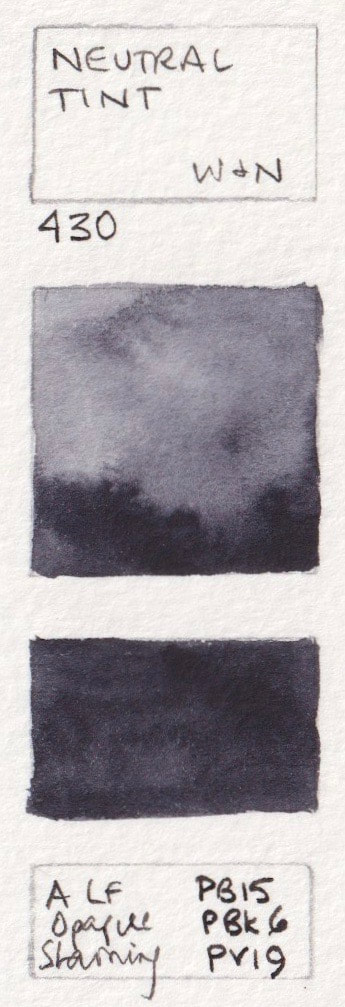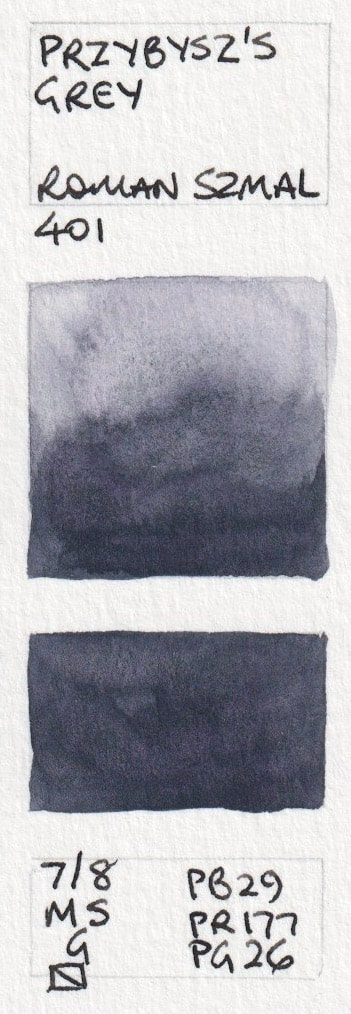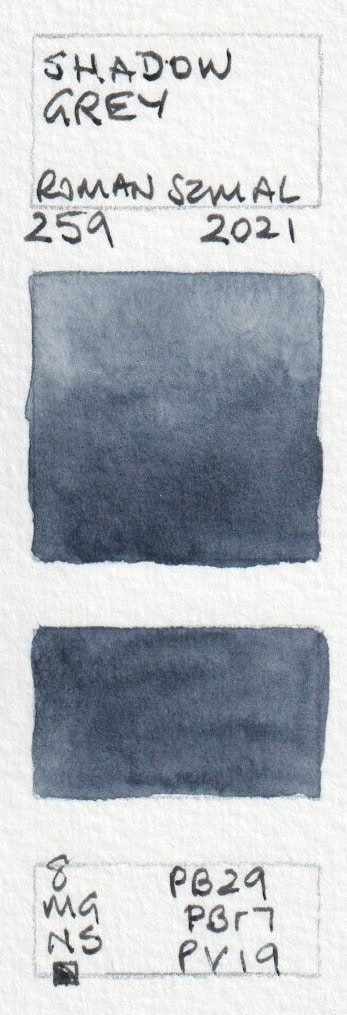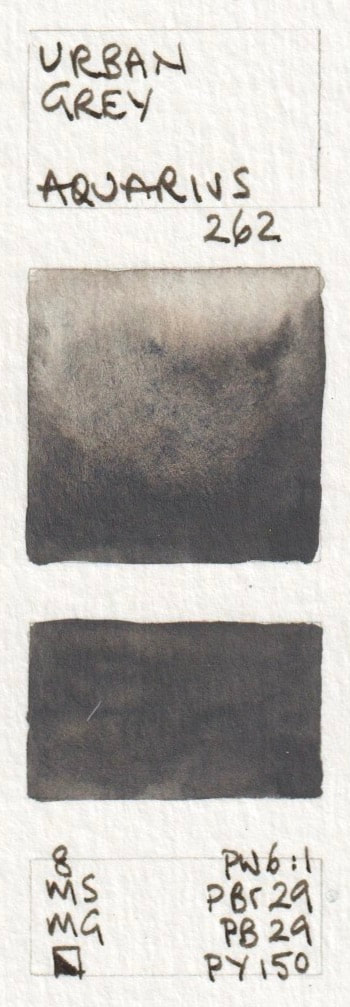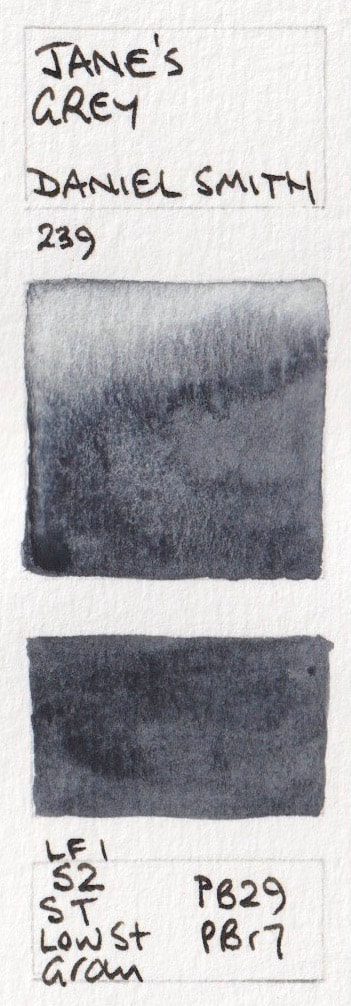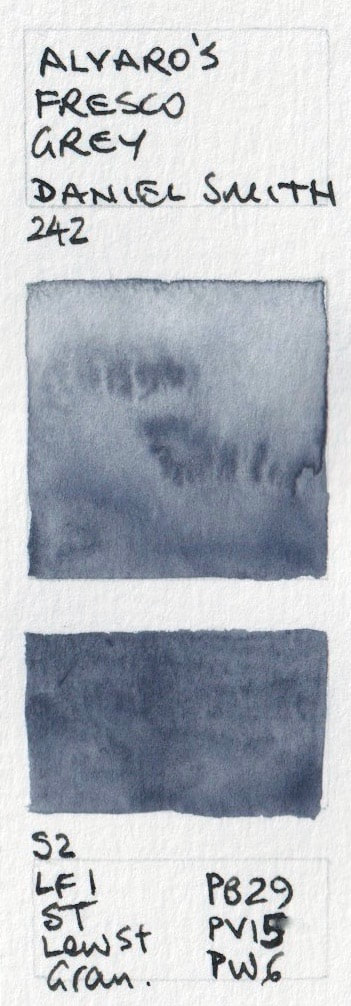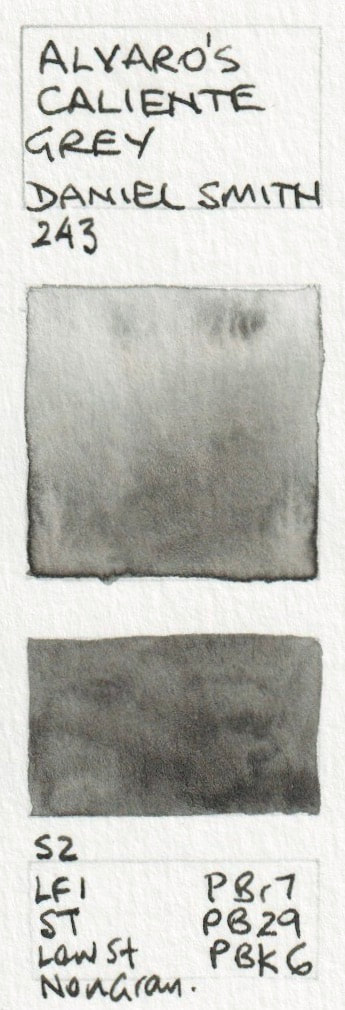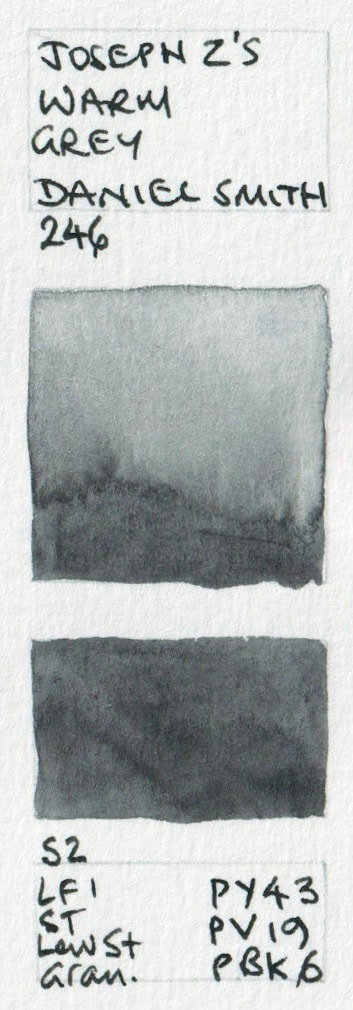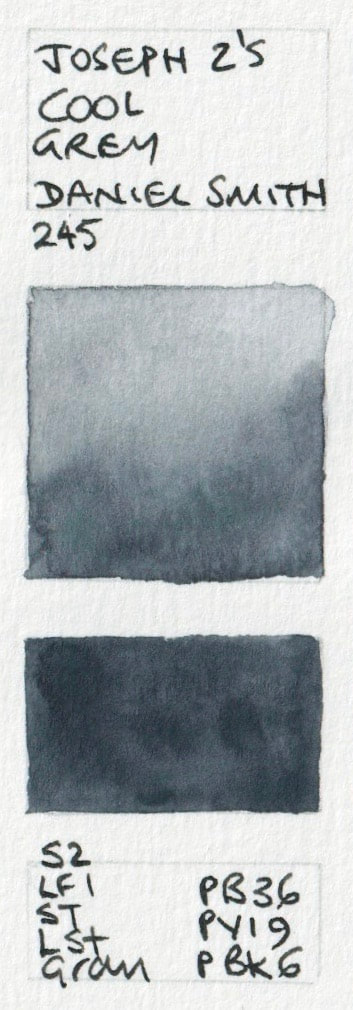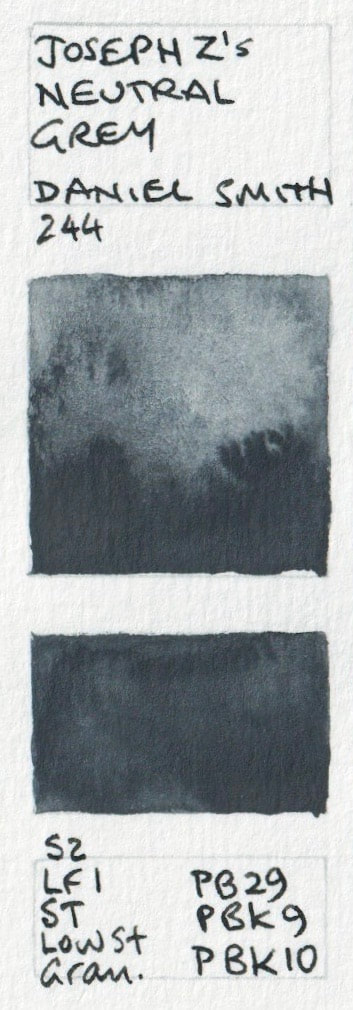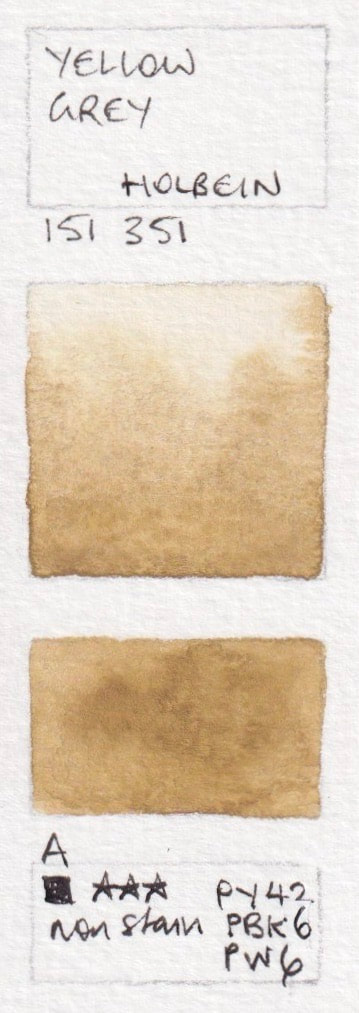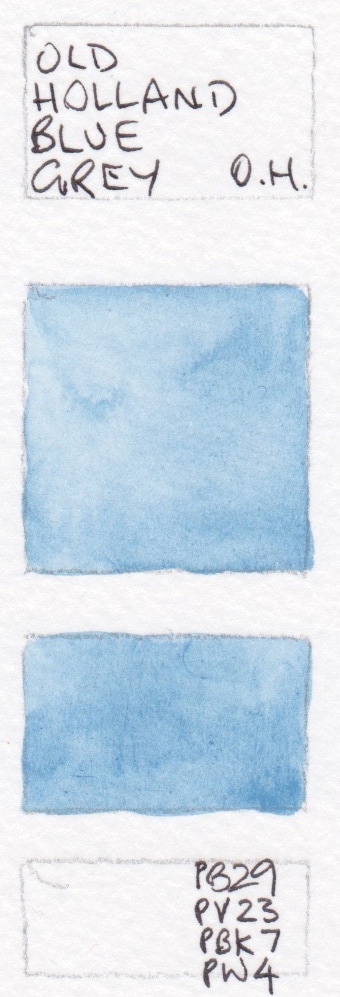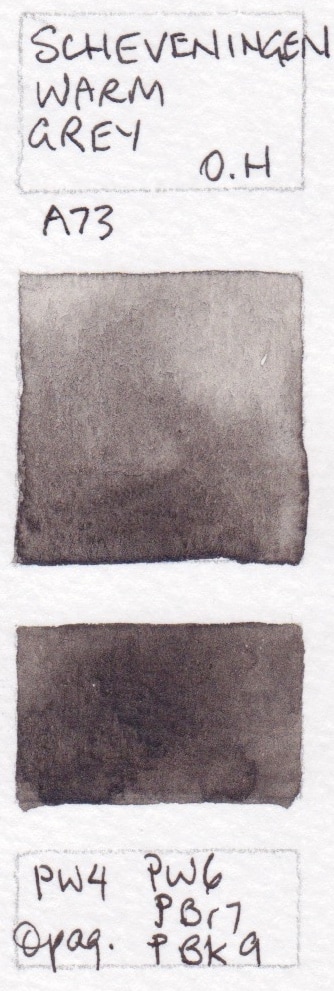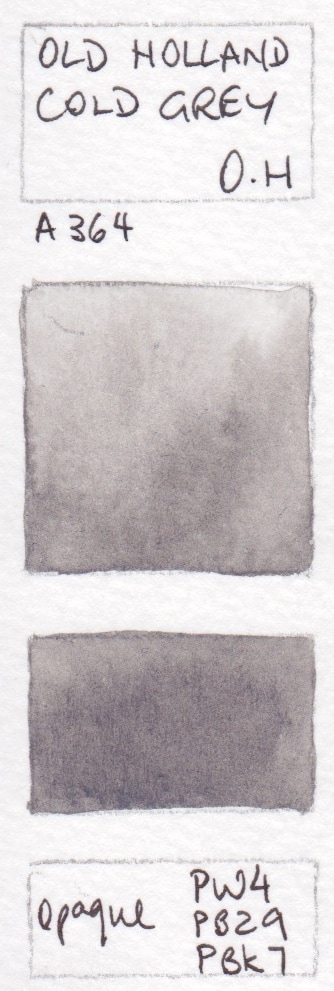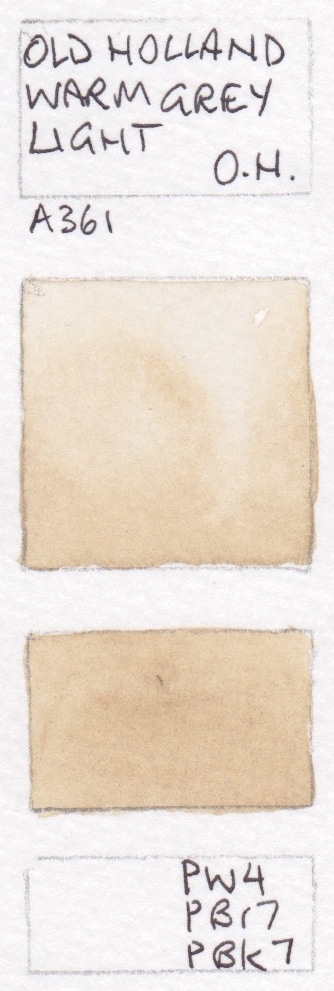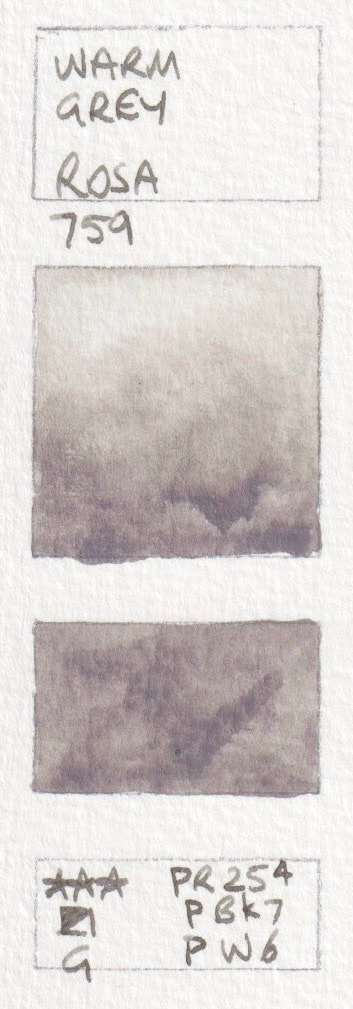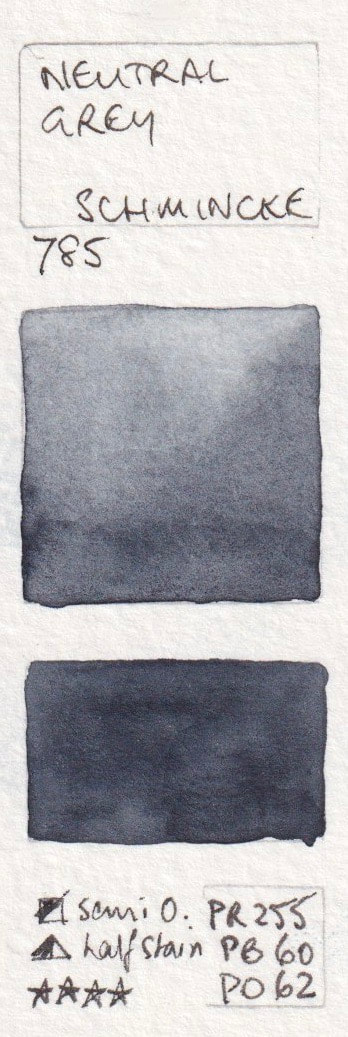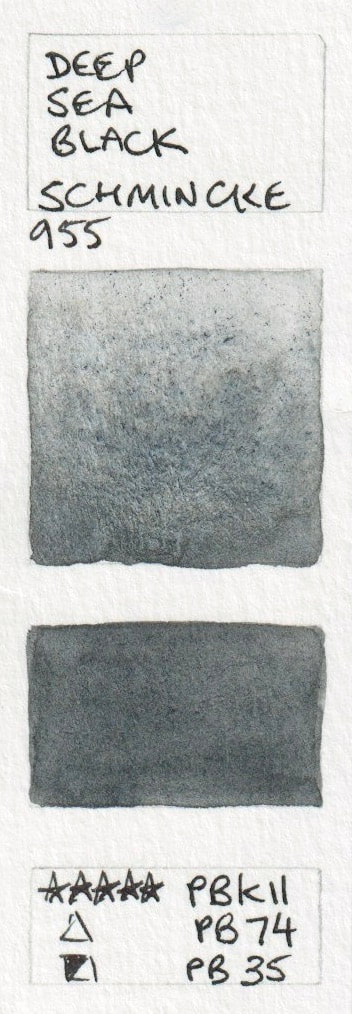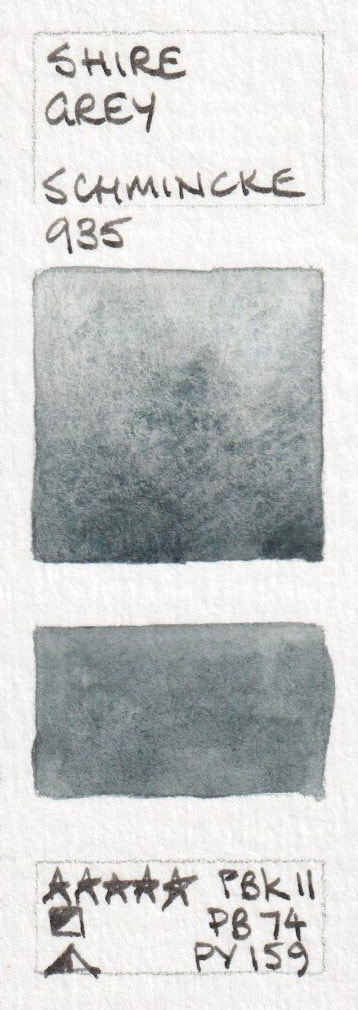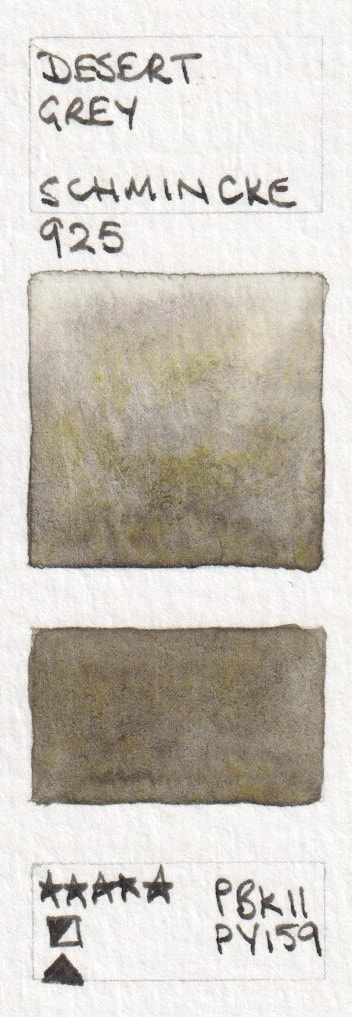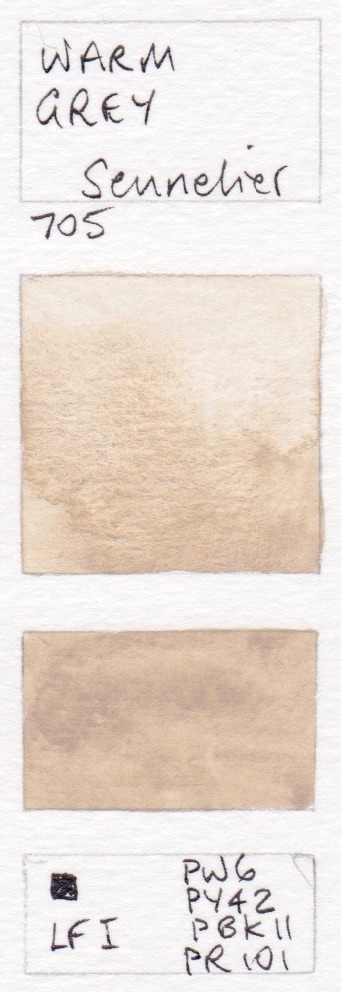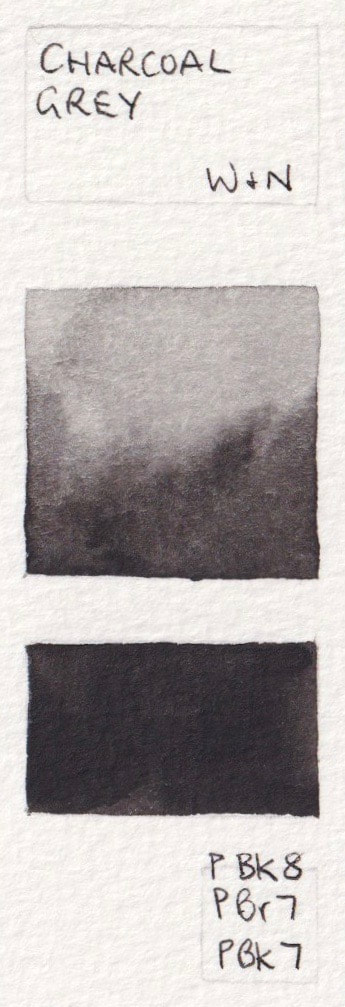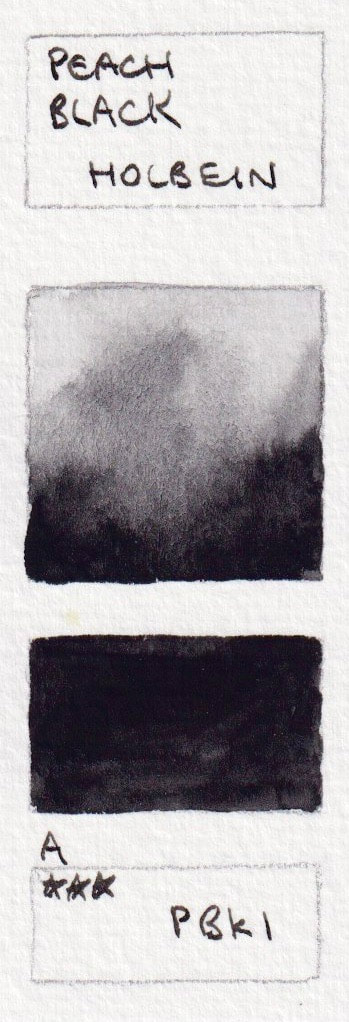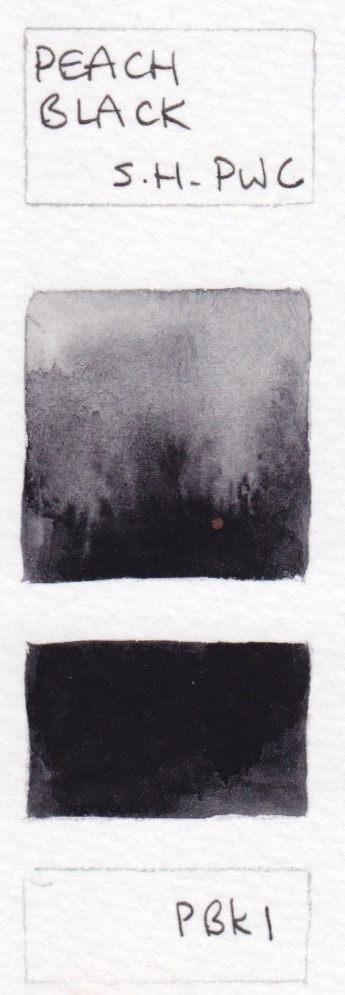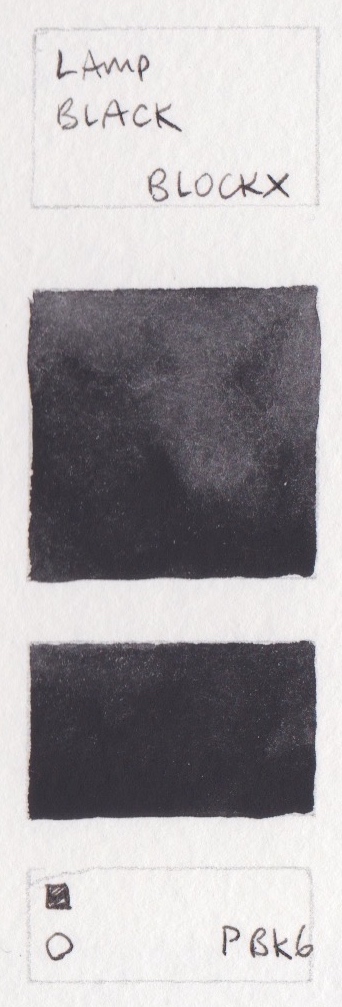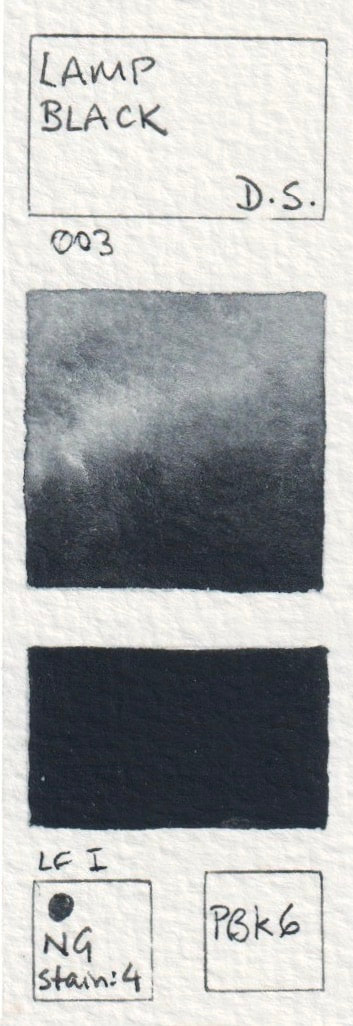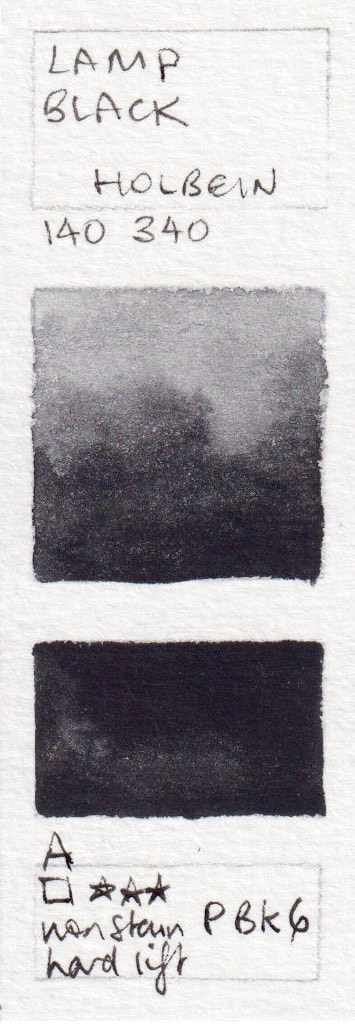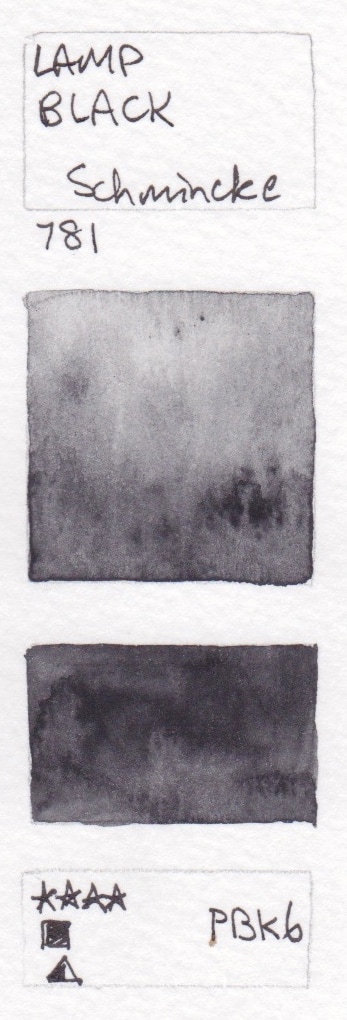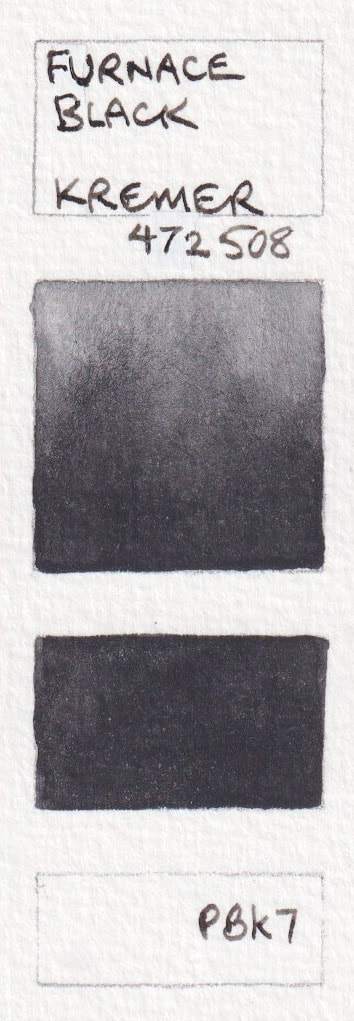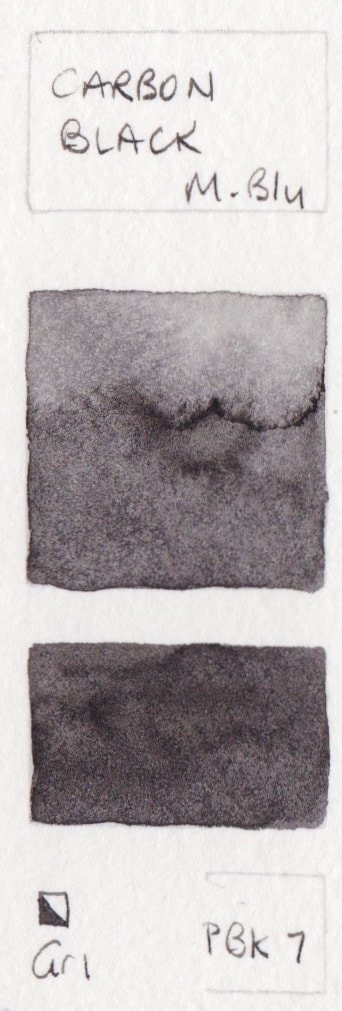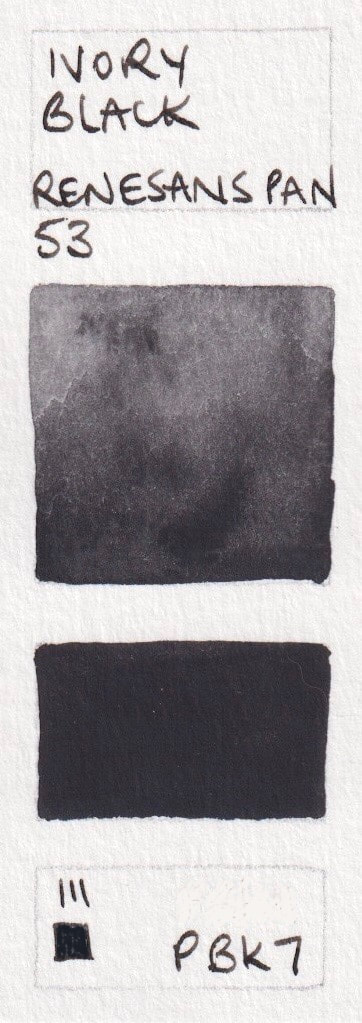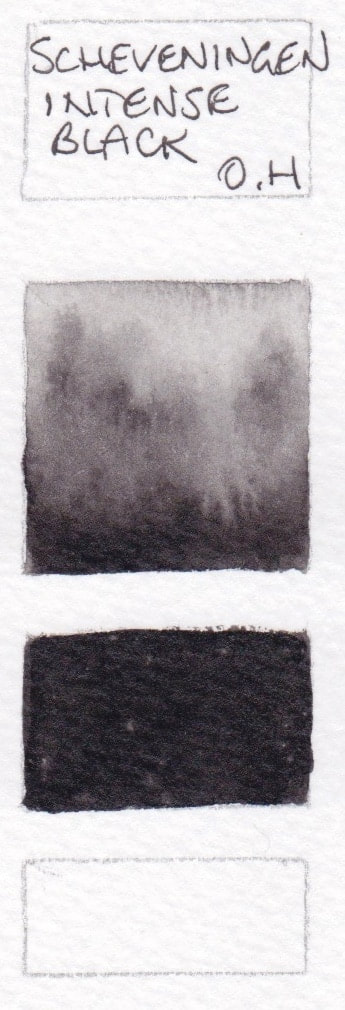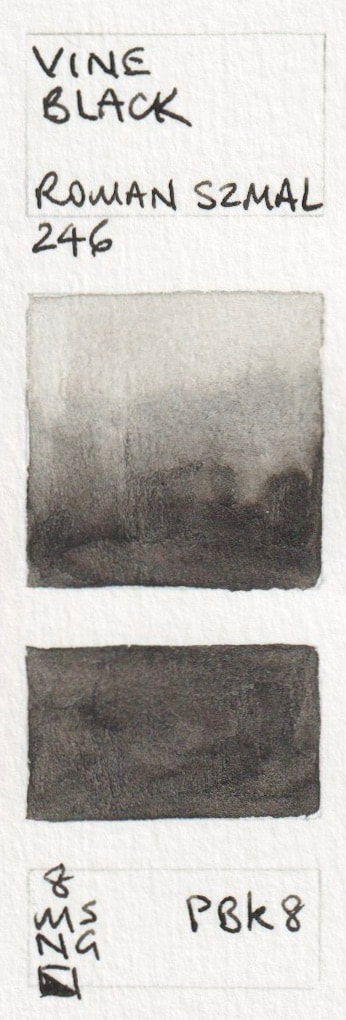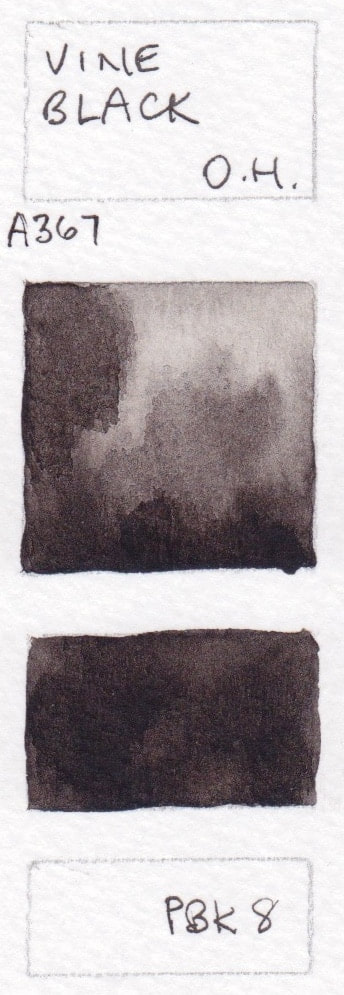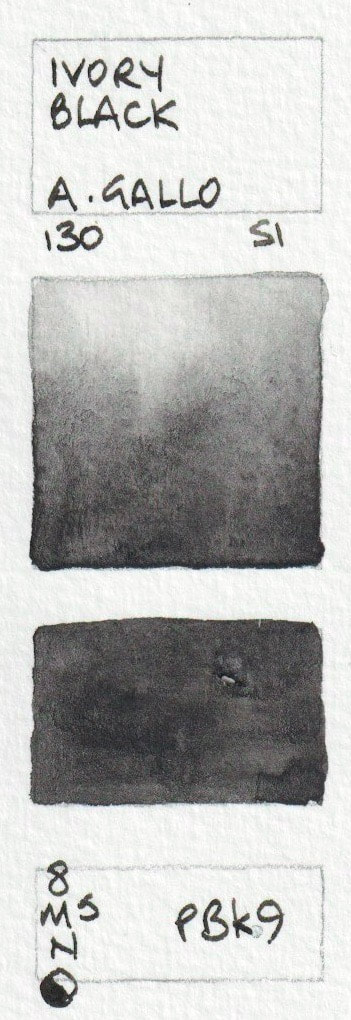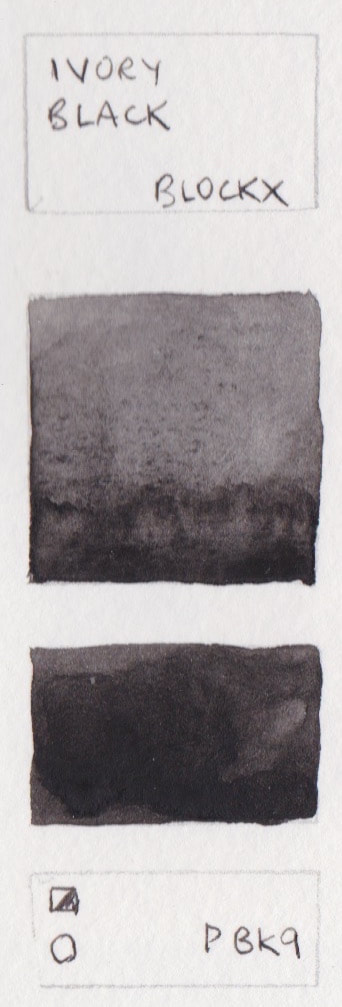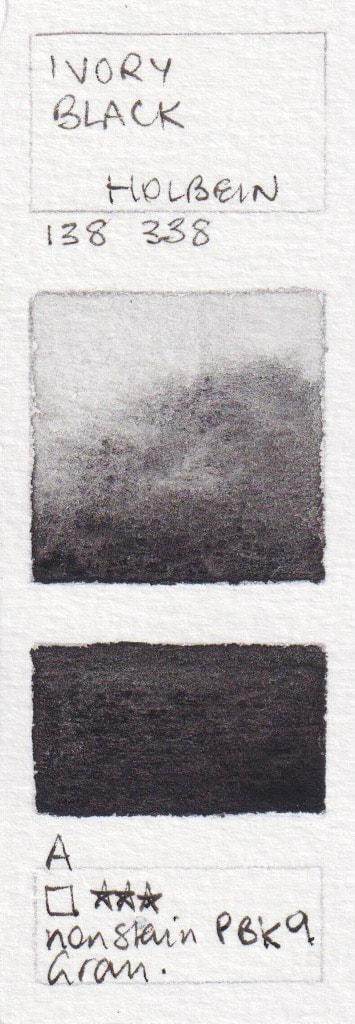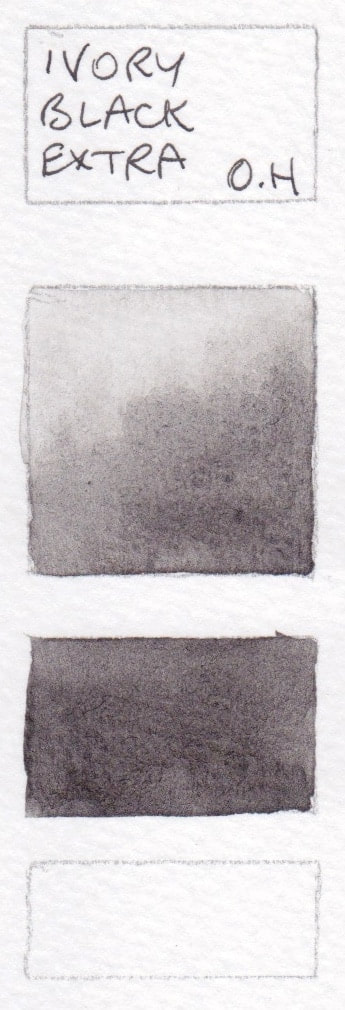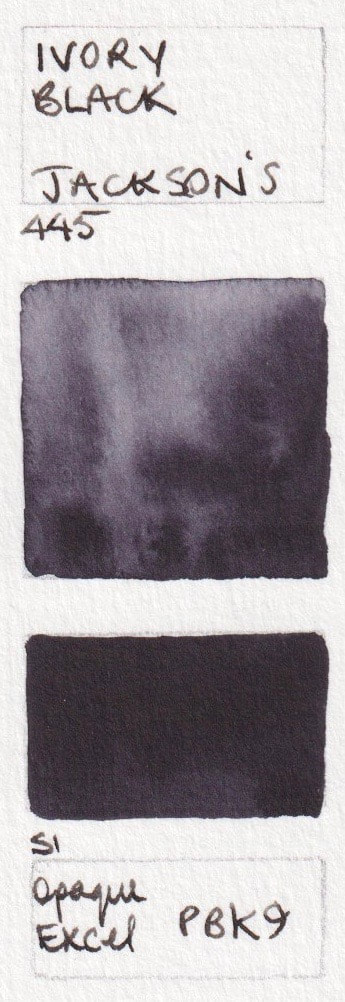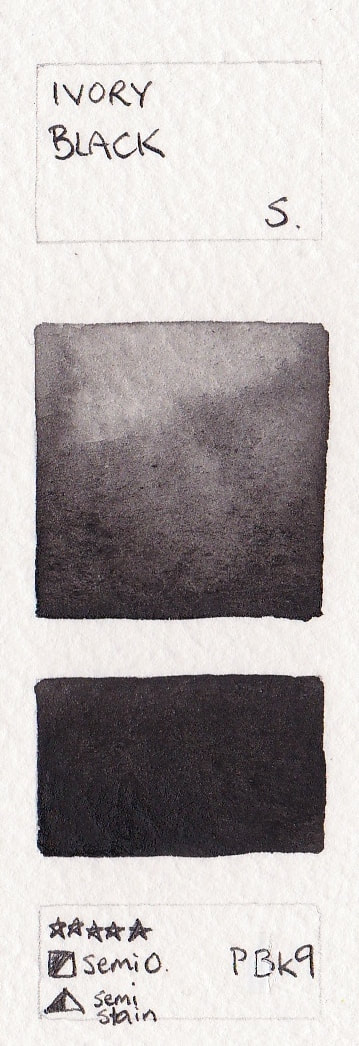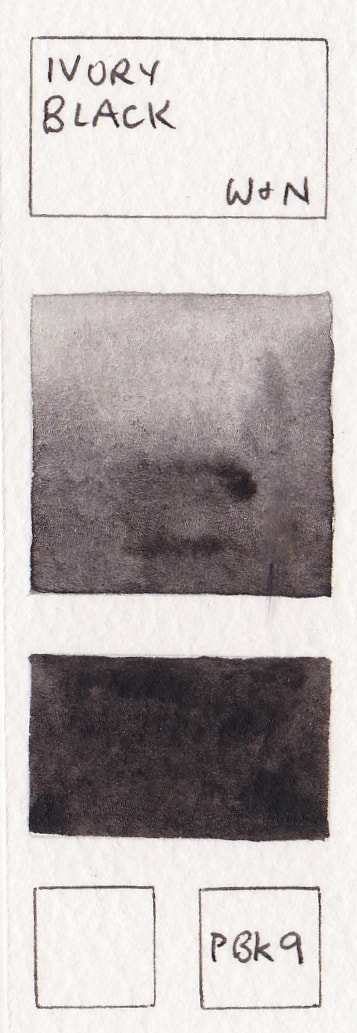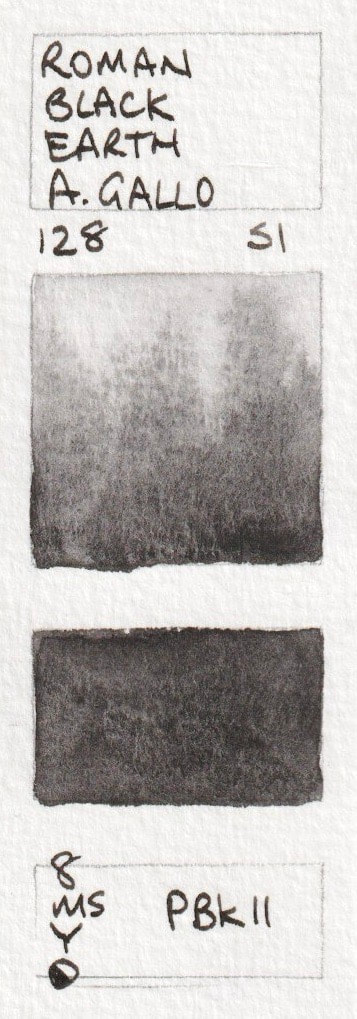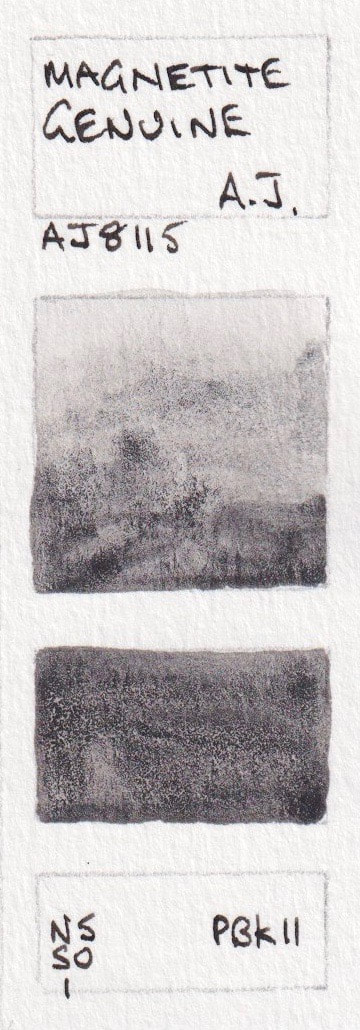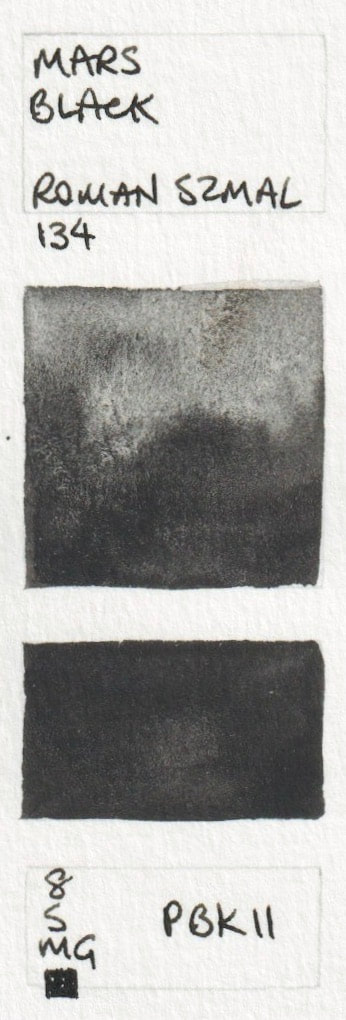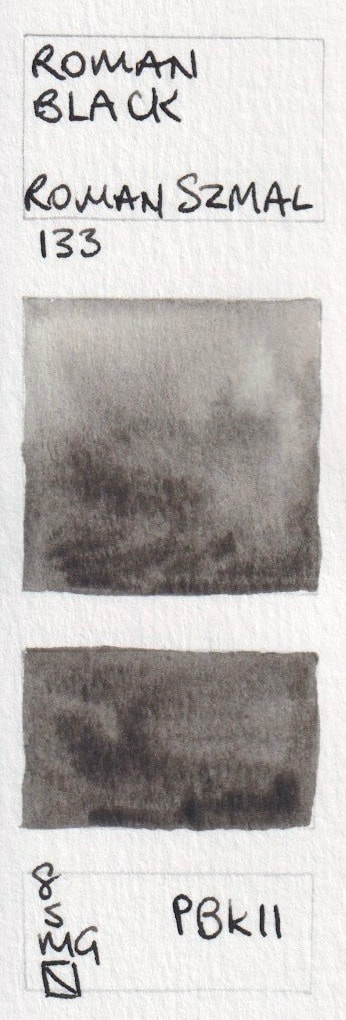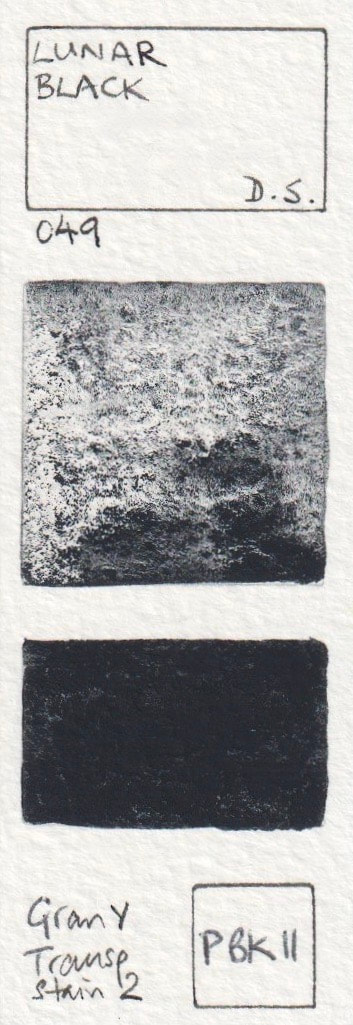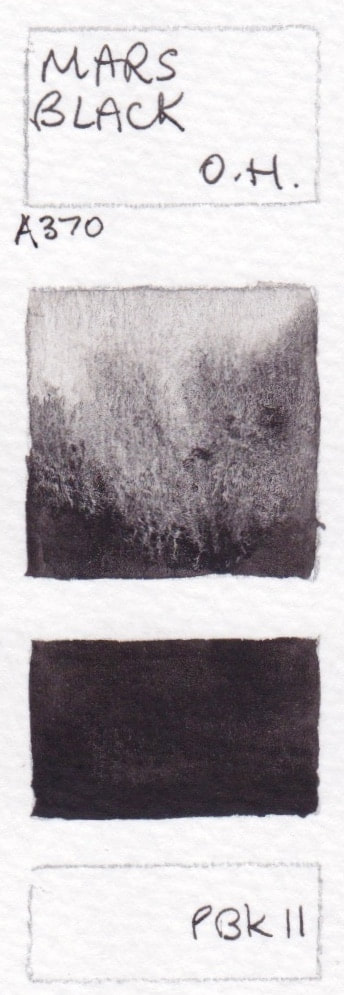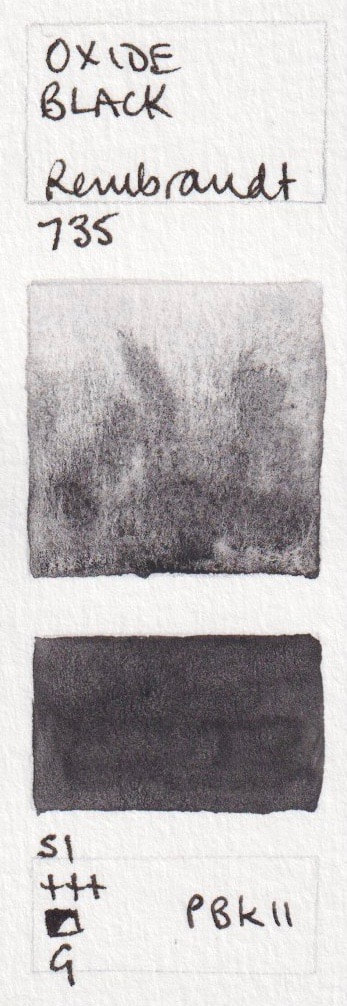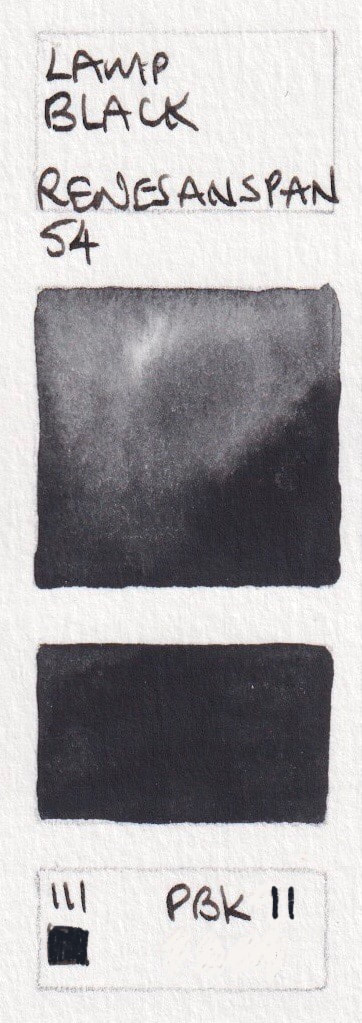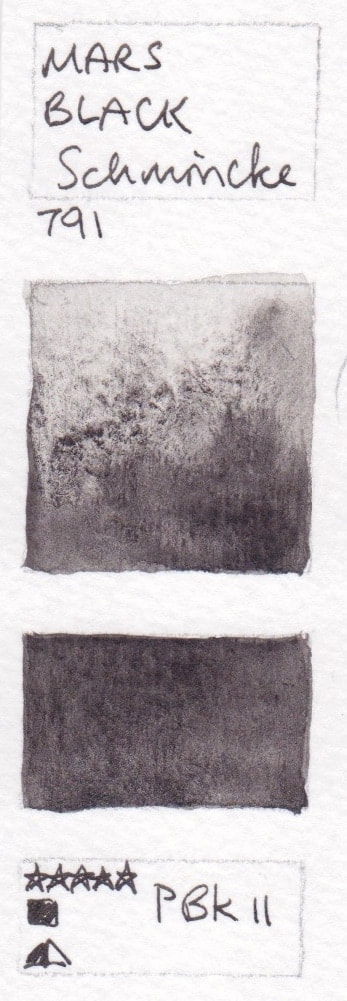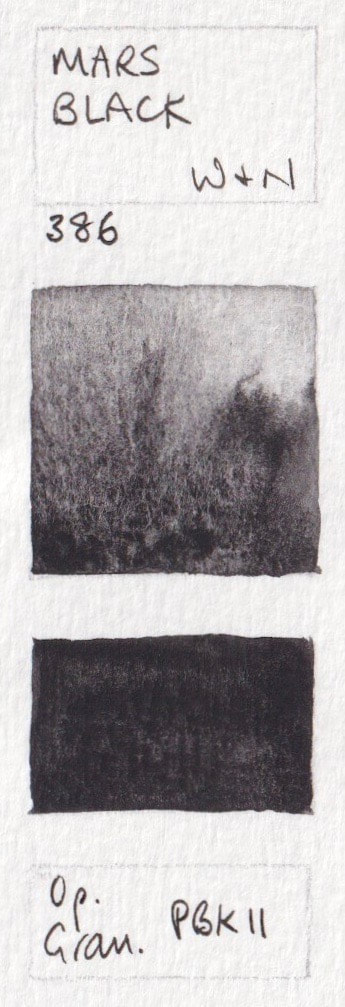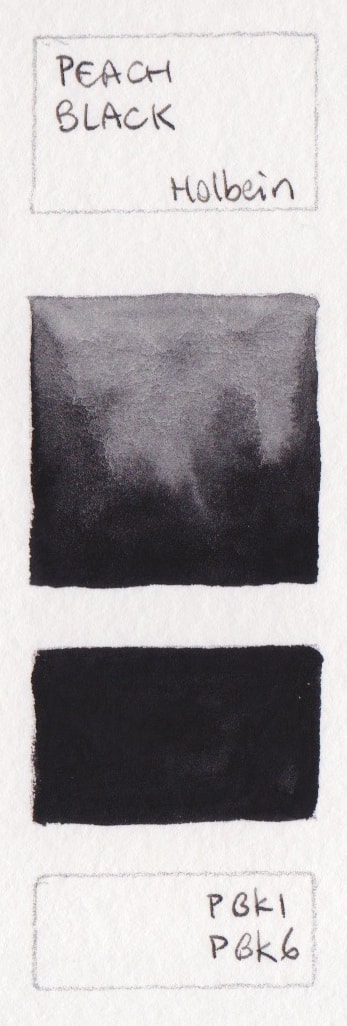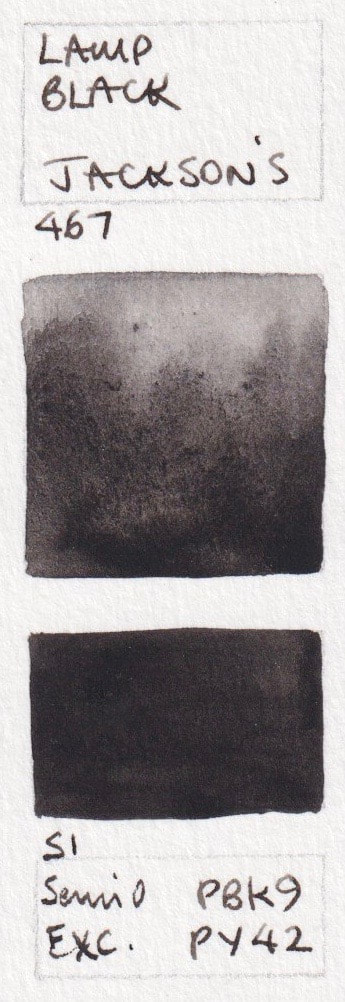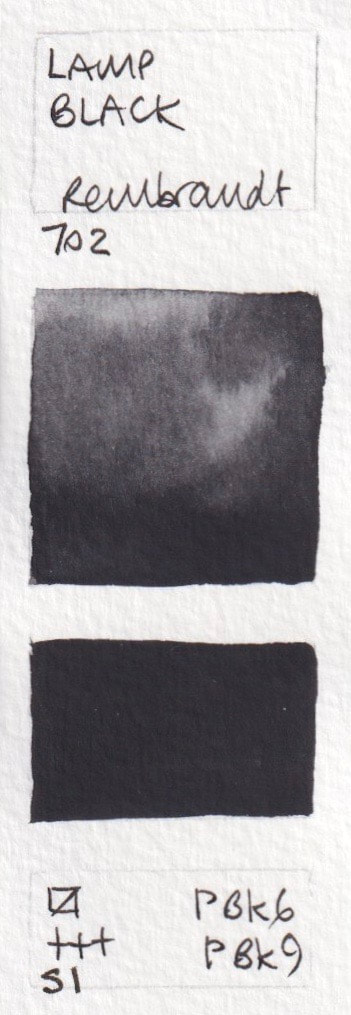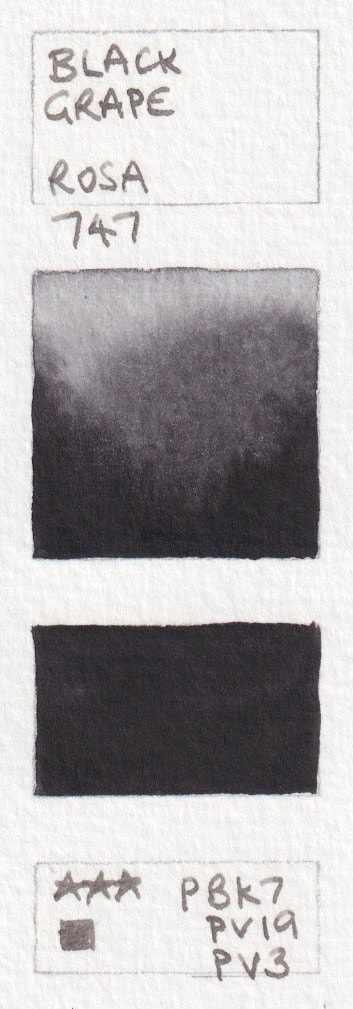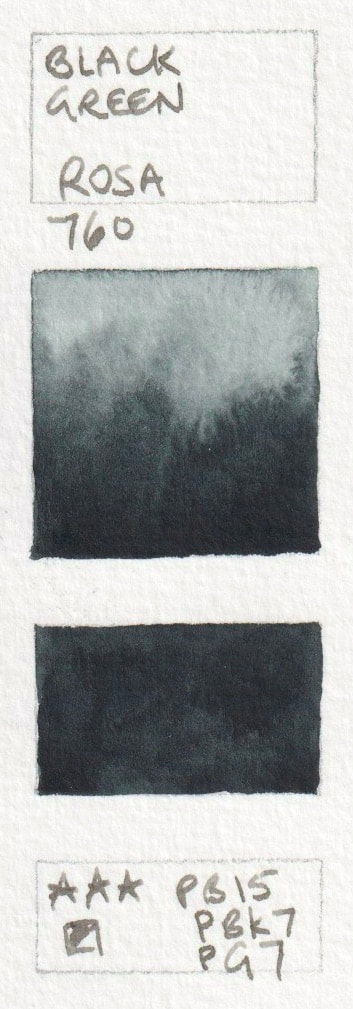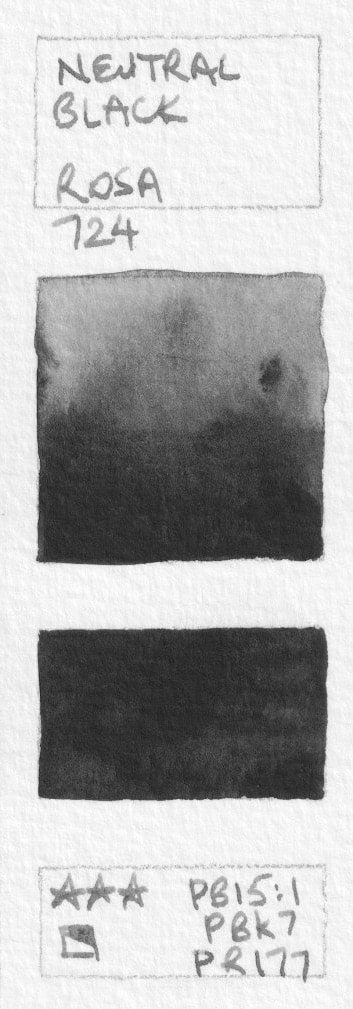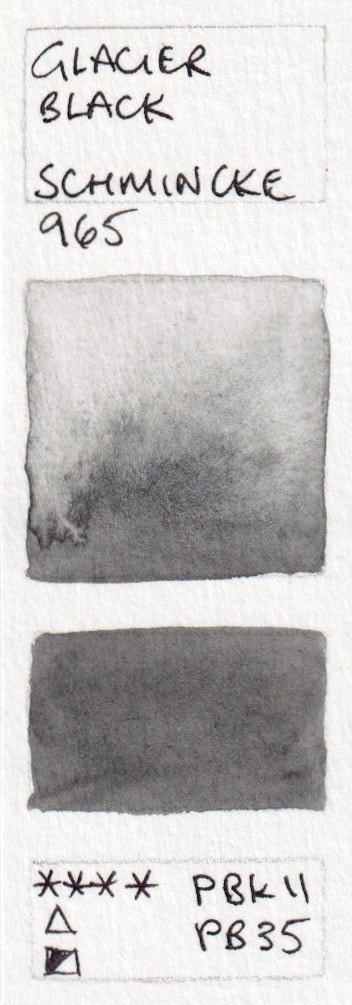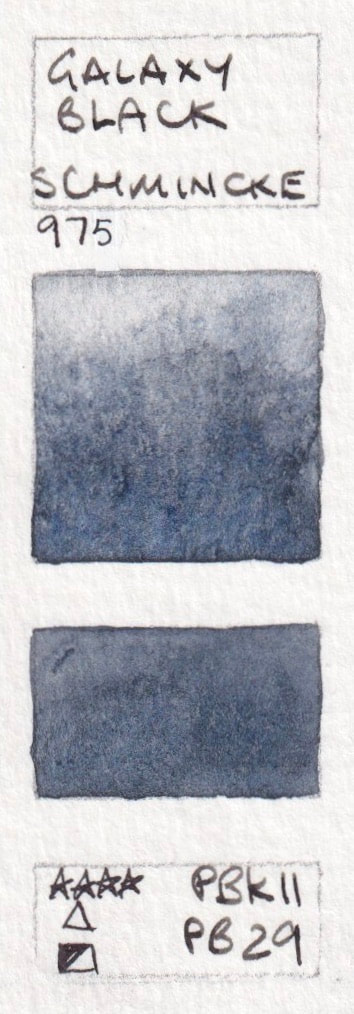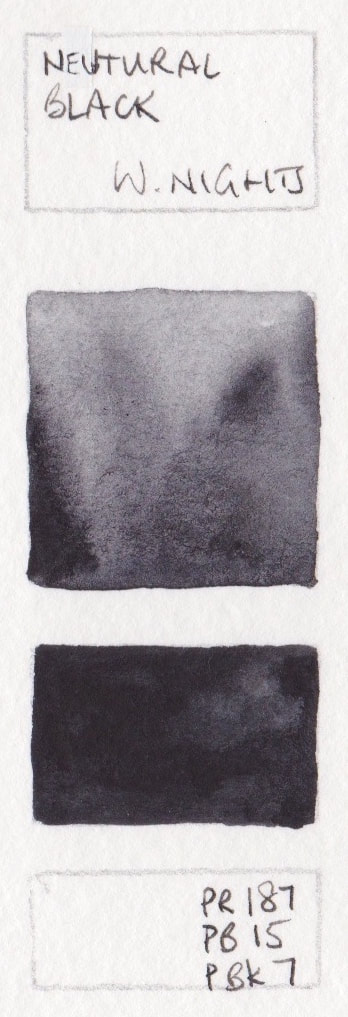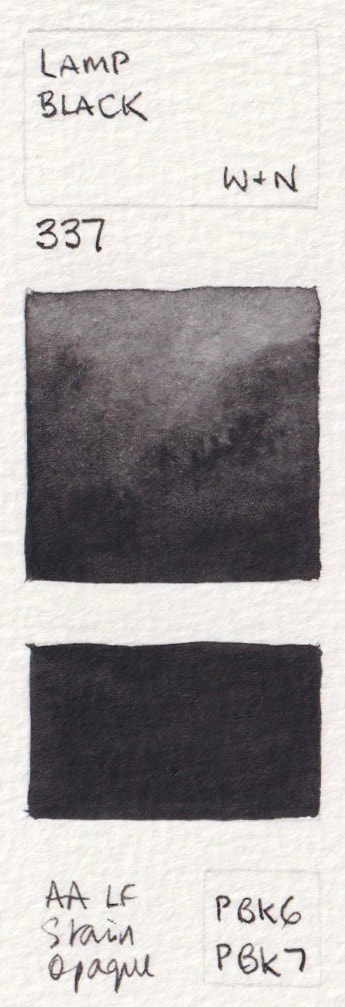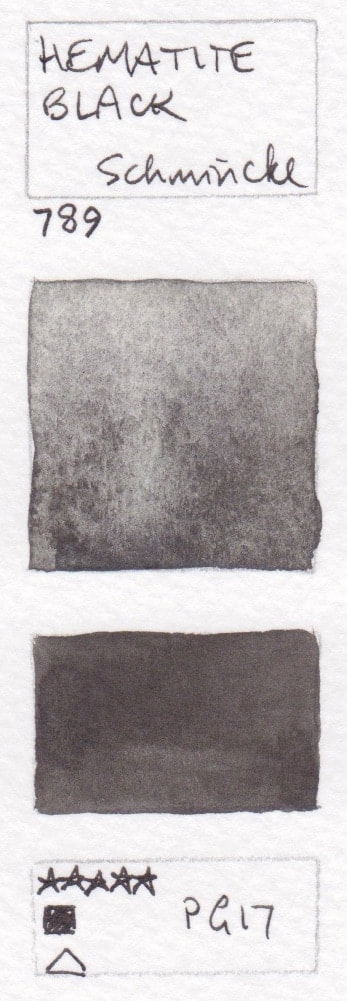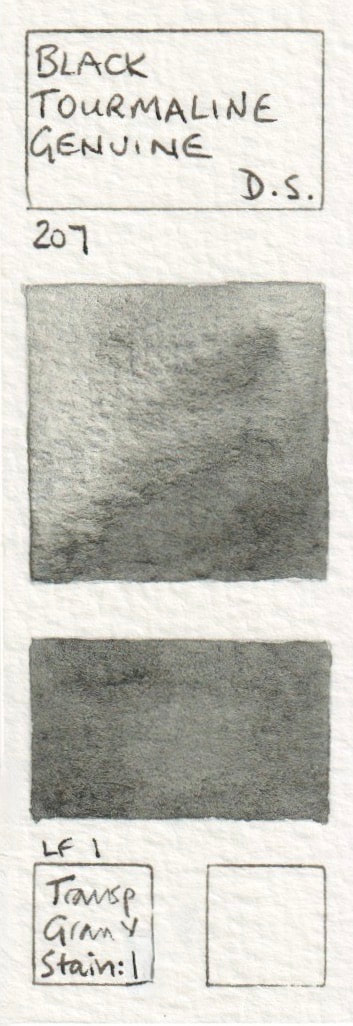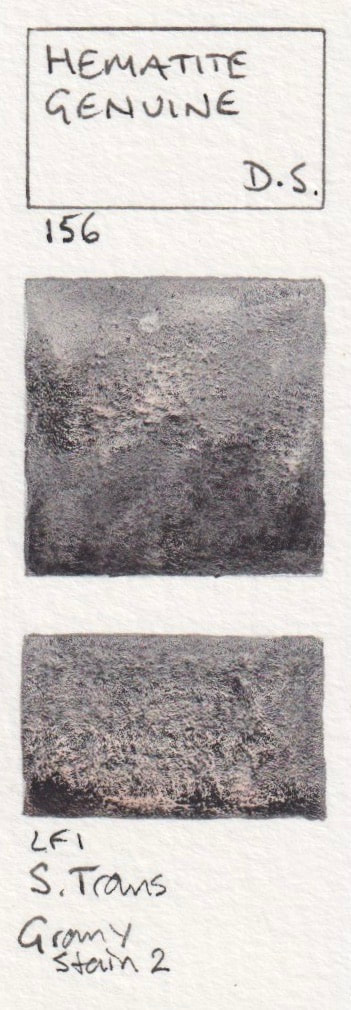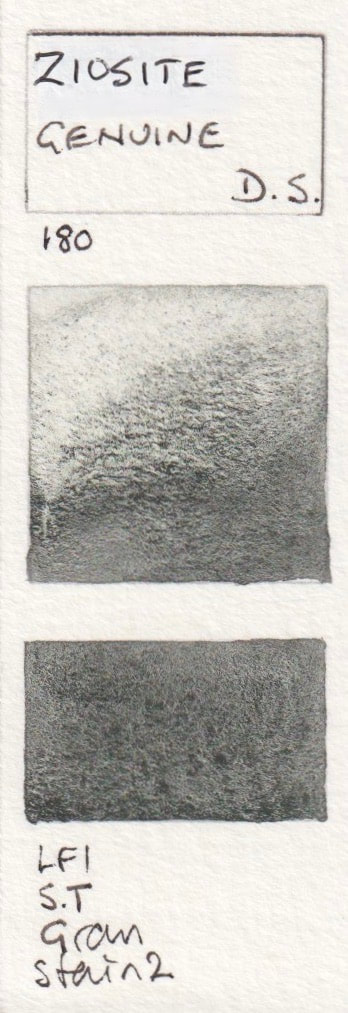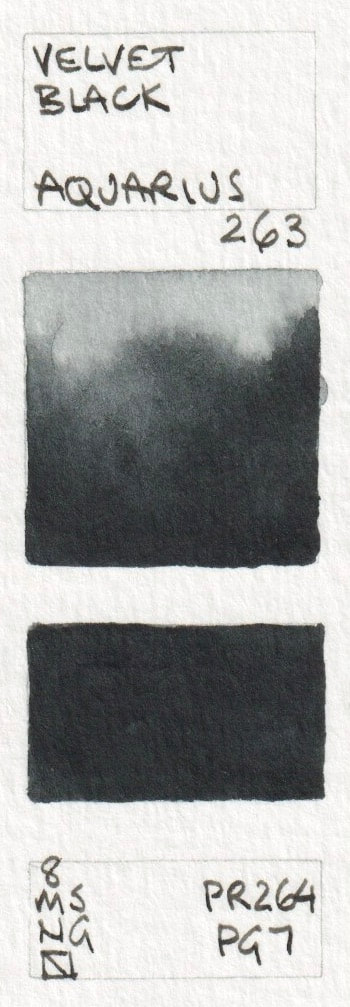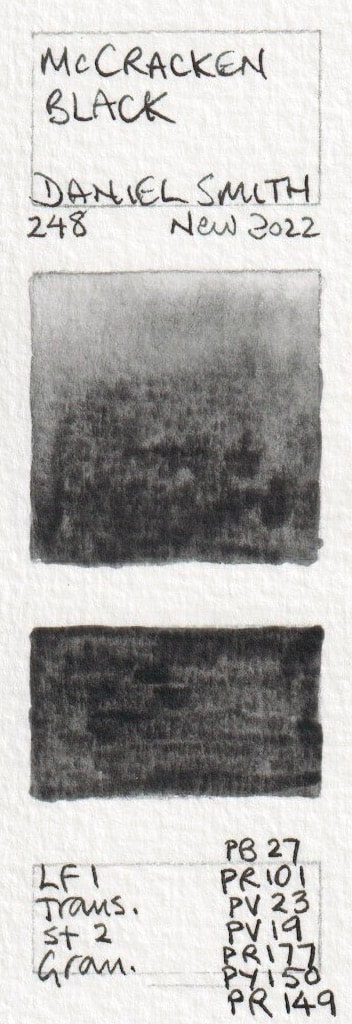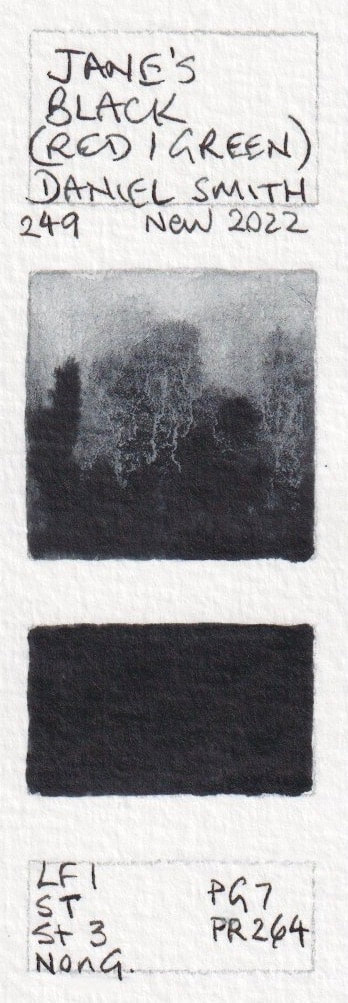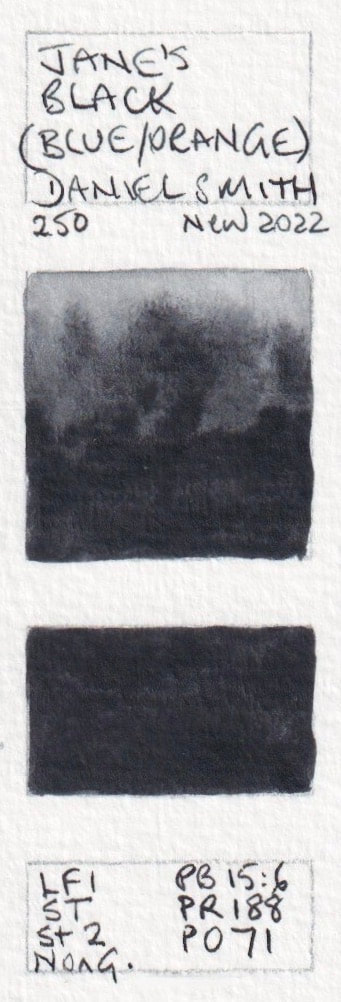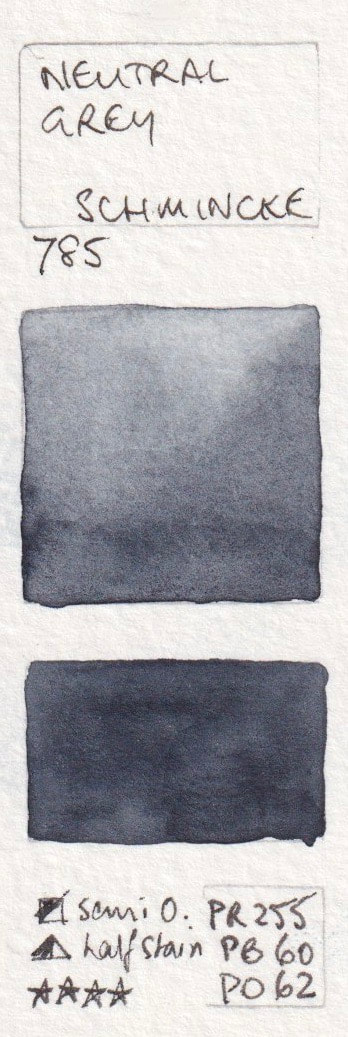|
|
If you find my website and blog useful, please consider making a one-off donation or perhaps a regular payment to help me keep my content free and up to date :-)
I am gradually updating all my swatches. Those marks with an * have been colour and pigment checked and are as close to accurate as I can get. |
10 - Light, Grey and Black Watercolour SwatchesThere are literally hundreds of artist quality watercolours available from many brands. I have tested many of them and created swatches as seen on the right. The square box is painted into a damp wash at the top to show the colour mixed in water, with more pigment added towards the bottom. The rectangle is painted in a juicy wash to show the mass-tone. The small squares at the bottom of the swatch have the pigment number and characteristics - staining, lightfast rating, granulation and transparency.
For more information on White pigments, see the Artiscreation White pigment database page here. Fro more on black pigments, see the Artiscreation Black pigment database here. The Handprint Black, Gray and White page is here, with excellent information based on lightfast tests completed in 2004. |
Lights, Greys and Blacks
Traditionally white is not used as a mixing colour in transparent watercolour paintings, as water is used to lighten a colour and the paper provides the 'white'. Many artists do add a touch of white watercolour or gouache to a painting to add a highlight or recover a lost white so the white shown here has a strip of permanent marker behind it so its opacity can be determined. I use a lot of an unusual granulating light pigment, Buff Titanium, which I have included here.
Black as also generally avoided as it can have a deadening effect on the other colours, though a convenient dark is very useful. There are a few different forms of Payne's Grey and Neutral Tint. Notice that most of them contain black, except the M.Graham Neutral Tint which is wonderfully dark but made PG7 and PV19. My preference is to make my own darks, my favourite being Jane's Grey, a mix of Ultramarine PB29 and Burnt Sienna PBr7, and various mixed blacks shown at the bottom of this page. I have included some black pigments here too of course, the most amazing being the incredibly granulating Lunar Black.
Black as also generally avoided as it can have a deadening effect on the other colours, though a convenient dark is very useful. There are a few different forms of Payne's Grey and Neutral Tint. Notice that most of them contain black, except the M.Graham Neutral Tint which is wonderfully dark but made PG7 and PV19. My preference is to make my own darks, my favourite being Jane's Grey, a mix of Ultramarine PB29 and Burnt Sienna PBr7, and various mixed blacks shown at the bottom of this page. I have included some black pigments here too of course, the most amazing being the incredibly granulating Lunar Black.
Whites made with PW4
Whites made with PW4 in alphabetical order by manufacture
- Chinese White - American Journey; Chinese White - Aquarius; Zinc White - Blockx; Chinese White - Daniel Smith; Chinese White - Jackson's (mixed pigment)
- Zinc White - Kremer; Chinese White - Maimeri Blu; Chinese White - Rembrandt; Zinc White - Rosa; Permanent Chinese White - Schmincke;
- Zinc White - White Nights; Chinese White - Winsor & Newton;
White Watercolours made with Titanium White PW6
- Titanium White - A Gallo; Titanium White - American Journey, Titanium White - Aquarius; Titanium White - Blockx; Titanium White* - Daniel Smith;
- Titanium White - Holbein; Chinese White - Holbein; Chinese White - Jackson's (pigment mix); Titanium White - Renesans Pan; Titanium White - Rosa;
- Titanium White (Opaque) - Schmincke; Titanium White - Winsor & Newton
Buff and Grey Watercolours made with PW6 and PW6:1
As well as a being an opaque white, unbleached variations of PW6 such as PW6:1 create granulating Buff Titanium and Grey Titanium options.
- Buff Titanium - A Gallo; Aquarius Grey - Aquarius; Buff Titanium - Aquarius; Buff Titanium - Arkaar PW6:1; Gray Titanium* - Daniel Smith;
- Buff Titanium - Daniel Smith;
Light Greys mixed pigment.
See also the single pigment greys above.
- French Gray - American Journey PW6 + PBr7, Sag Harbor Gray - American Journey PBr7 + PY43 + PW6 Coastal Fog - American Journey PBr7 + PW6; Pat's Coastal Blue - American Journey PBr7 + PB36, Buff Titainium - American Journey PW6 + PBr7;
- Australian Grey - Art Spectrum; Grey of Grey - Holbein PBk6 + PW6; Titanium Buff - Rembrandt PW6 + PBr7
Greys - Davy's Grey
Davy's Grey by Winsor & Newton was named after Henry Davy and was originally made from Powdered slate (PBk19), iron oxide and carbon black. Shown here are:
- Getz Gray (Davy's) - American Journey PW6 + PBk6 + PG7; Davy's Gray, Da Vinci PW6 + PBk6 + PG7; Davy's Grey - Holbein PBr7 + PBk6 + PW6; Davy's Grey - Old Holland PG23 + PW4 + PBr7; Da Vinci, Davy's Grey - Rembrandt PBK11 + PBr7;
- Davy's Grey - Winsor & Newton PBk6 + PG17 + PW4.
Greys - single pigment
There are also some interesting single pigment greys such as Graphite by Daniel Smith, which is very opaque with a slight sheen. I like using this with pencil drawings. There is also an interesting Grey Titanium made with PW6 or PW6:1. Others shown here are made with PBk7 PBk10, PBk19 and PBk26 along with some Primatek grey colours.
- Slate Gray - A Gallo PBk19; Aquarius Grey - Aquarius PW6:1; Graphite - Aquarius PBk10. New 2023; Graphite Gray* - Daniel Smith PBk10; Gray Titanium - Daniel Smith PW6; Hematite Genuine - Daniel Smith;
- Black Tourmaline Genuine - Daniel Smith; Ardoise Gray - QoR PBk19; Spinal Grey - Rembrandt PBk26; Charcoal Grey - Schmincke PBk7; Graphite Grey, Schmincke PBk10 (discontinued);
- Anthracite - Schmincke
Greys - Payne's Grey/Payne's Gray
Payne's Grey is a very common premixed colour, usually made with a black and a blue pigment, though originally, according to Wikipedia it was made with Yellow Ochre, Prussian Blue and Crimson Lake, which would be a much more interesting mix to paint with. It was named after William Payne and first appeared in English in 1835. I experimented with this mix as shown on my blog here. The versions available commercially are created using a different formula, usually containing and black pigment with a staining blue pigment.
- Payne's Gray - A Gallo PB15.1 + PBk7 + PV19; Payne's Gray - American Journey PBk6 + PB27; Payne's Grey - Aquarius PBk9 + PB27+ PR264; Payne's Grey - Blockx PBk11 + PB29 + PB15:1; Payne's Grey - Daler Rowney PBk7 + PB29;
- Payne's Gray* - Daniel Smith PBk9 + PB29 + PY42; Payne's Blue Grey* - Daniel Smith PB60 + PBk6; Payne's Gray - Da Vinci PBk 9 + PB29; Payne's Grey - Holbein PBk6 + PB15 + PR122; Payne's Grey - Jackson's PV19 + PB15:1 + PBk7;
- Paynes' Gray - Maimeri Blu (discontinued); Payne's Grey - Old Holland PB29+ PBk9; Payne's Gray - M.Graham PBk9 + PB29; Payne's Grey - Rembrandt PBk6 + PB15; Payne's Grey -Renesans half pan PBk11 PB27;
- Payne's Grey - Rosa PB15:1 + PV19 + PBk7; Payne's Grey - Sennelier PV19 + PB15:1 + PBk7; Payne's Grey - Schmincke PR101 + PB29 + PBk7; Payne's Grey Bluish - Schmincke PBk6 + PB15:6 + PB13:2; Payne's Grey - Winsor & Newton PB15 + PBk6 + PV19
Grey - Neutral Tint
Neutral Tint was also created in the 18th century, and was originally made with Light Red (red iron oxide), indigo or iron blue and gamboge or yellow ochre. (Bruce MacEvoy) It is a grey designed to deepen other colours without changing them i.e. if you add neutral tint to a yellow will go deeper yellow rather than turning green. These days it is usually made using a black pigment by most manufacturers, though M.Graham and Old Holland are the exception to this.
- Neutral Tint - American Journey PBk6 + PB15 + PV19; Neutral Tint - Aquarius PB60 + PBk6 + PV19; Neutral Tint - Blockx PBk11 + PB15 + PV19; Neutral Tint* - Daniel Smith PBk 6 + PV19 + PB15; Neutral Tint - Holbein PBk6 + PB1 + PV19;
- Neutral Tint - Jackson's PB60, PBk7, PR209; Neutral Tint - MaimeriBlu PBk7; Neutral Tint - M.Graham PV19 + PG7; Neutral Tint - Rembrandt PBk6, PV19; Neutral Tint - Schmincke PR122 + PB60 + PBk7;
- Neutral Tint Old Holland PB15:2 + PV19 + PBr7 + PR259; Neutral Tint - Winsor & Newton PB15, PBk6, PV19
Other Mixed Pigment Greys
There are many ways to mix a grey, my favourite being Ultramarine + Burnt Sienna (see the Jane's Grey swatch below) but many mixing opposites will create interesting grey hues. I've written more about mixed greys and blacks on my blog - All that Grey and Custom watercolour mixes - a question of greys. See also Payne's Grey and Neutral Tint above.
Most commercial greys are made from black and white pigments, with or without additional coloured pigments.
Most commercial greys are made from black and white pigments, with or without additional coloured pigments.
- Przybysz's Grey - Aquarius watercolours PB29 + PR177 + PG26; Shadow Grey - Aquarius PB29 + PBr7 + PV19; Urban Grey - Aquarius PW6:1 + PBr25 + PB29 + PY150. New 2023; Jane's Grey* - Daniel Smith PB29 + PBr7; Alvaro's Fresco Grey* - Daniel Smith PB29 + PV15 + PW6;
- Alvaro's Caliente Grey* - Daniel Smith PBr7 + PB29 + PBk6; Joseph Z's Warm Grey* - Daniel Smith PY43 + PB19 + PBk6; Joseph Z's Cool Grey* - Daniel Smith PB36 + PV19 + PBk6; Joseph Z's Neutral Grey* - Daniel Smith PB29 + PBk9 + PBk10; Yellow Grey - Holbein PY42 + PBK6 + PW6;
- Old Holland Blue Grey - Old Holland PB29 + PV23 + PBk7 + PW4; Scheveningen Warm Grey - Old Holland PW6 + PBr7 + PBk9; Old Holland Cold Grey - Old Holland PW4+PB29+PBK7; Old Holland Warm Grey Light - Old Holland PW4 + PBr7 + PBk7; Warm Grey - Rosa PR254 + PBk7 + PW6;
- Neutral Grey - Schmincke PR255, PB60, PO62; Deep Sea Black* - Schmincke PBk11 + PB74 + PB35; Shire Grey* - Schmincke PBk11 + PB74 + PY159; Desert Grey* - Schmincke PBk11 + PY159Warm Grey - Sennelier PW6 + PY42 + PBk11 + PR101;
- Charcoal Grey - Winsor & Newton PBk8 + PBr7 + PBk7
Blacks
Best known are Ivory Black, Lamp Black and Mars Black, but the pigments used for the various blacks are not consistent among different brands. There is also Peach Black, Vine Black etc. Black pigments include PBk1, PBk6, PBk7, PBk8, PBk9, PBk10 and PBk11, PBk26 and the deep green pigments PBk31 and PBk32 shown in the Greens section.
PBk1
Peach Black - Holbein; Peach Black - ShinHan PWC
PBk6
- Lamp Black - American Journey; Lamp black - Blockx; Lamp Black* - Daniel Smith; Lamp Black - Da Vinci; Lamp Black, Holbein;
- Ivory Black - Rembrandt; Lamp black - Schmincke
Blacks made with PBk7
- Lamp Black - Daler Rowney; Furnace Black - Kremer; Carbon Black - MaimeriBlu; Scheveningen Intense Black - Old Holland Ivory Black - Renesans half pan
PBk8
Vine Black* - Aquarius; Vine Black - Old Holland
PBk9
- Ivory Black - A Gallo; Ivory Black - Aquarius; Ivory Black - Blockx; Ivory Black* - Daniel Smith; Ivory Black - Da Vinci;
- Ivory Black - Holbein; Ivory Black - Old Holland; Ivory Black - Jackson's; Ivory Black - Schmincke; Ivory Black - Winsor & Newton
Blacks made with PBk11
While I don't choose to use black pigments in my painting generally, I love the granulation of Lunar Black (Daniel Smith) for special effects. PBk11 is also known as Mars Black, Magnetite Genuine and Oxide Black.
- Roman Black Earth - A Gallo; Magnetite Genuine - American Journey; Aquarius Black - Aquarius; Mars Black - Aquarius; Roman Black - Aquarius;
- Lunar Black* - Daniel Smith; Mars Black - Old Holland; Oxide Black - Rembrandt; Lamp Black - Renesans half pan; Mars Black - Schmincke;
- Mars Black - Winsor & Newton
Mixed Pigment Blacks
- Peach Black - Holbein PBk1 + PBk 6 (discontinued); Lamp Black - Jackson's PBk9, PY42; Lamp Black - Rembrandt PBk6 + PBk9; Black Grape - Rosa PBk7 + PV19 + PV3; Black Green - Rosa PB15 + PBk7 + PG7;
- Neutral Black - Rosa PB15:1 + PBk7 + PR177; Deep Sea Black - Schmincke PBk11 + PB74 + PB35; Glacier Black - Schmincke PBk11 + PB35; Galaxy Black - Schmincke PBk11 + PB29; Neutral Black - White Nights PR187 + Pb15 + PBk7;
- Lamp Black - Winsor & Newton PBk6 + PBk7
PG17
Hematite Black - Schmincke
Primatek blacks or near blacks
Each of these colours leans a little away from a neutral black. Black Yourmaline has a greenish hue, as does Ziosite Genuine. Hematite Genuine has a strangely warm undertone - almost like black on a peachy yellow. It is difficult to capture.
Black Tourmaline Genuine* - Daniel Smith; Hematite Genuine - Daniel Smith; Zoisite Genuine* - Daniel Smith
Black Tourmaline Genuine* - Daniel Smith; Hematite Genuine - Daniel Smith; Zoisite Genuine* - Daniel Smith
Blacks made without black pigments
* Blacks don't have to contain black pigments, though in commercial colours they usually do, so I tend to make my own as convenience pre-mixed colours. See my blog posts about mixed blacks and greys here and here. Read about the new Daniel Smith Jane's Blacks here.
Recently Daniel Smith released three new mixed blacks as part of their signature series.
Recently Daniel Smith released three new mixed blacks as part of their signature series.
- Velvet Black - Aquarius PR264 + PG7. (New 2023); Mc Cracken Black* - Daniel Smith PB27 + PR101 + PV23 + PV19 + PR177 + PY150 + PR149 (new 2022); Jane's Black (Red/Green)*- Daniel Smith PG7 + PR264 (new 2023); Jane's Black (Blue/Orange)* - Daniel Smith PO71 + PR188 + PB15:6 (new 2023); Neutral Tint - M.Graham PV19 + PG7;
- Neutral Grey - Schmincke PR255 + PB60 + PO62.
These swatches are painted and added as a guide. The intention is show the characteristics of each colour when painted. The colour reproduction is not perfect but hopefully will still be helpful used in conjunction with the manufacturer's website. I am gradually updating all swatches, and have marked them with an * once they have been checked.
hank you to those of you, from Canada, Sweden, Australia and the USA, who have helped me with this section by sharing your favourite colours. If you notice errors please let me know so I can correct them. If you have artist quality watercolour that are not shown here and want to help me build up this resource, also please let me know :-)
hank you to those of you, from Canada, Sweden, Australia and the USA, who have helped me with this section by sharing your favourite colours. If you notice errors please let me know so I can correct them. If you have artist quality watercolour that are not shown here and want to help me build up this resource, also please let me know :-)
This page was last updated in October 2023
